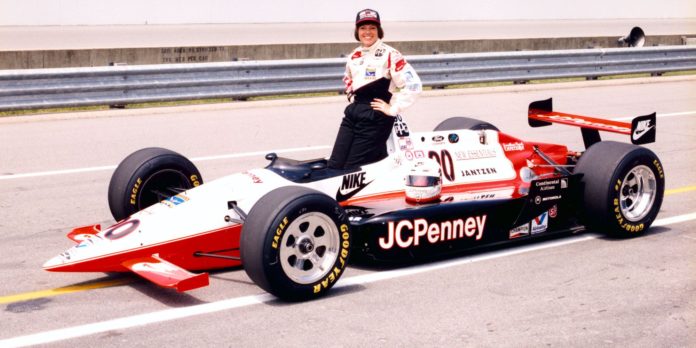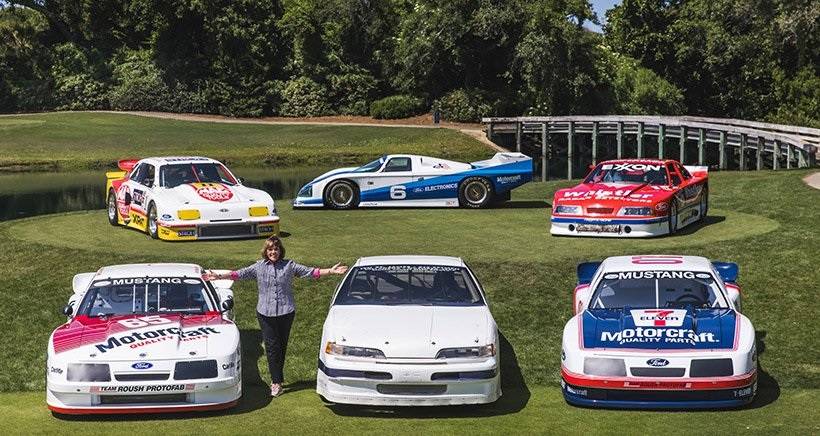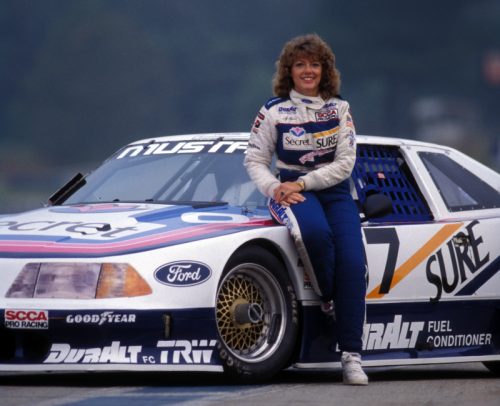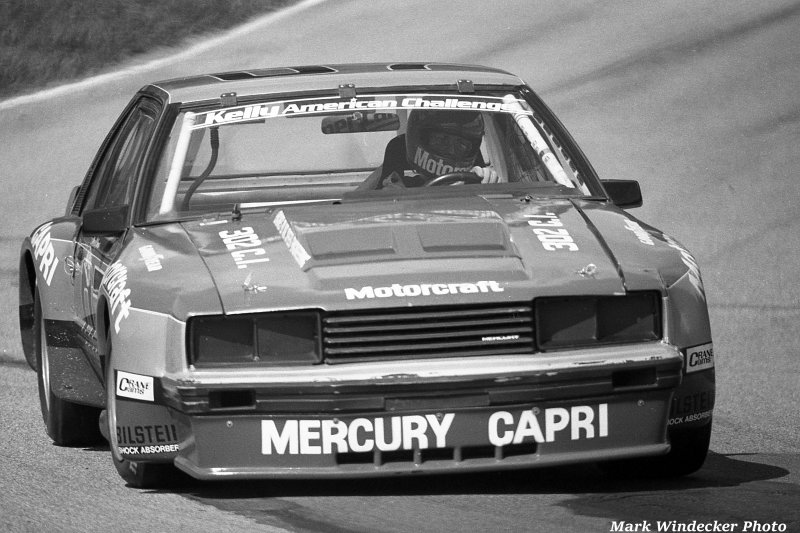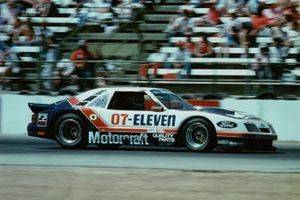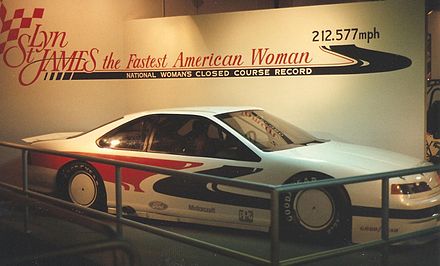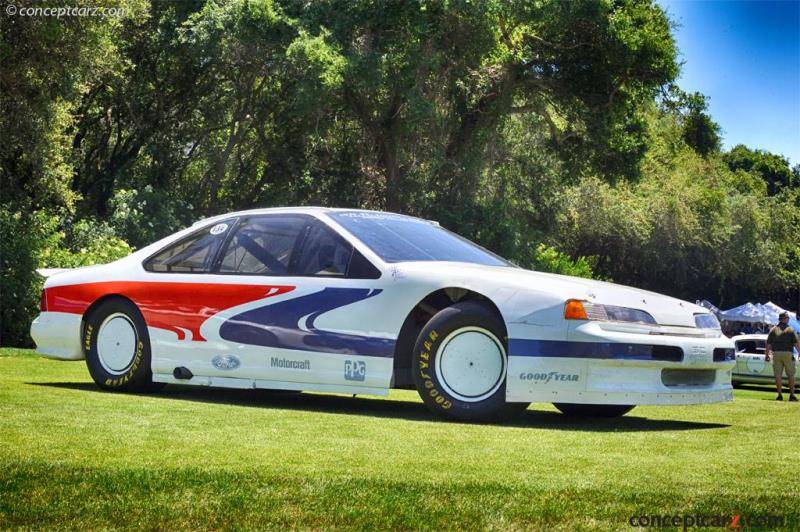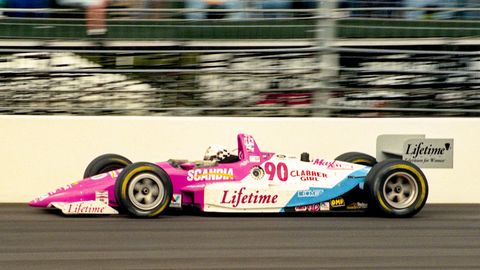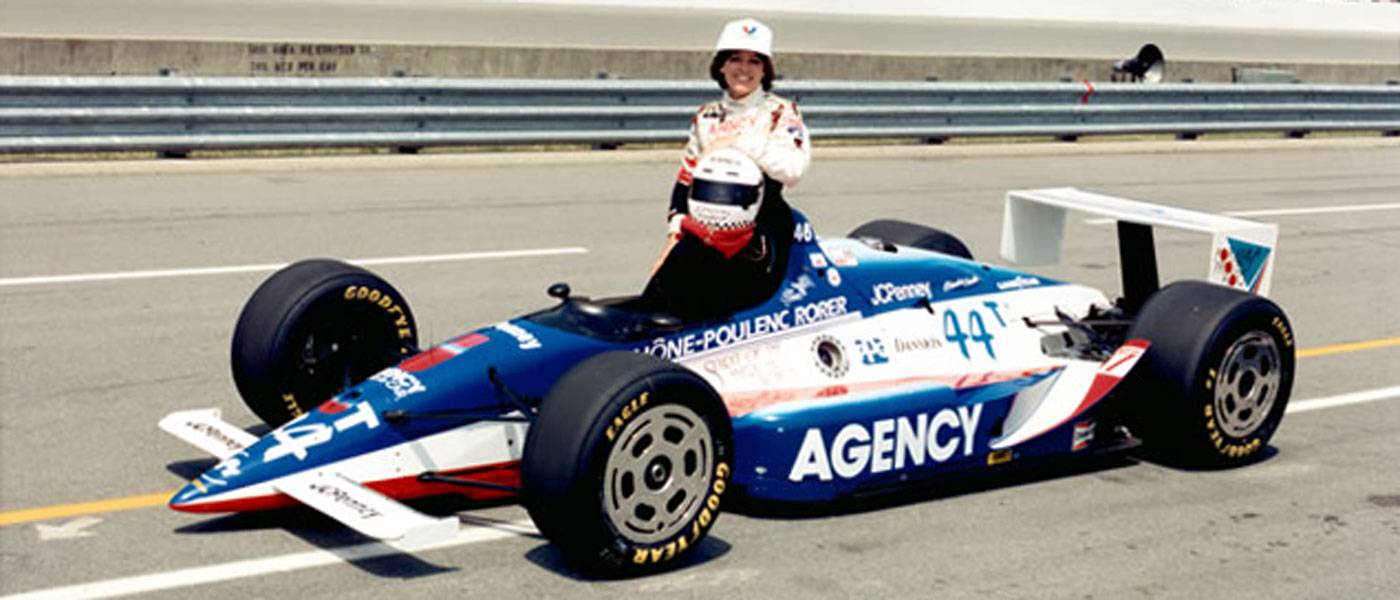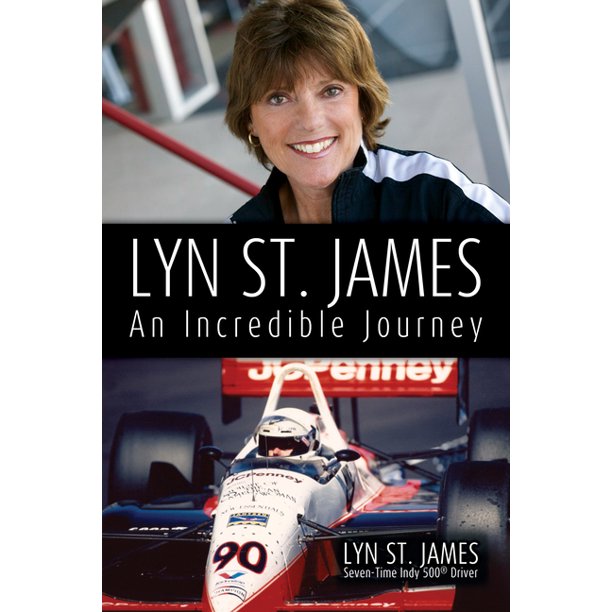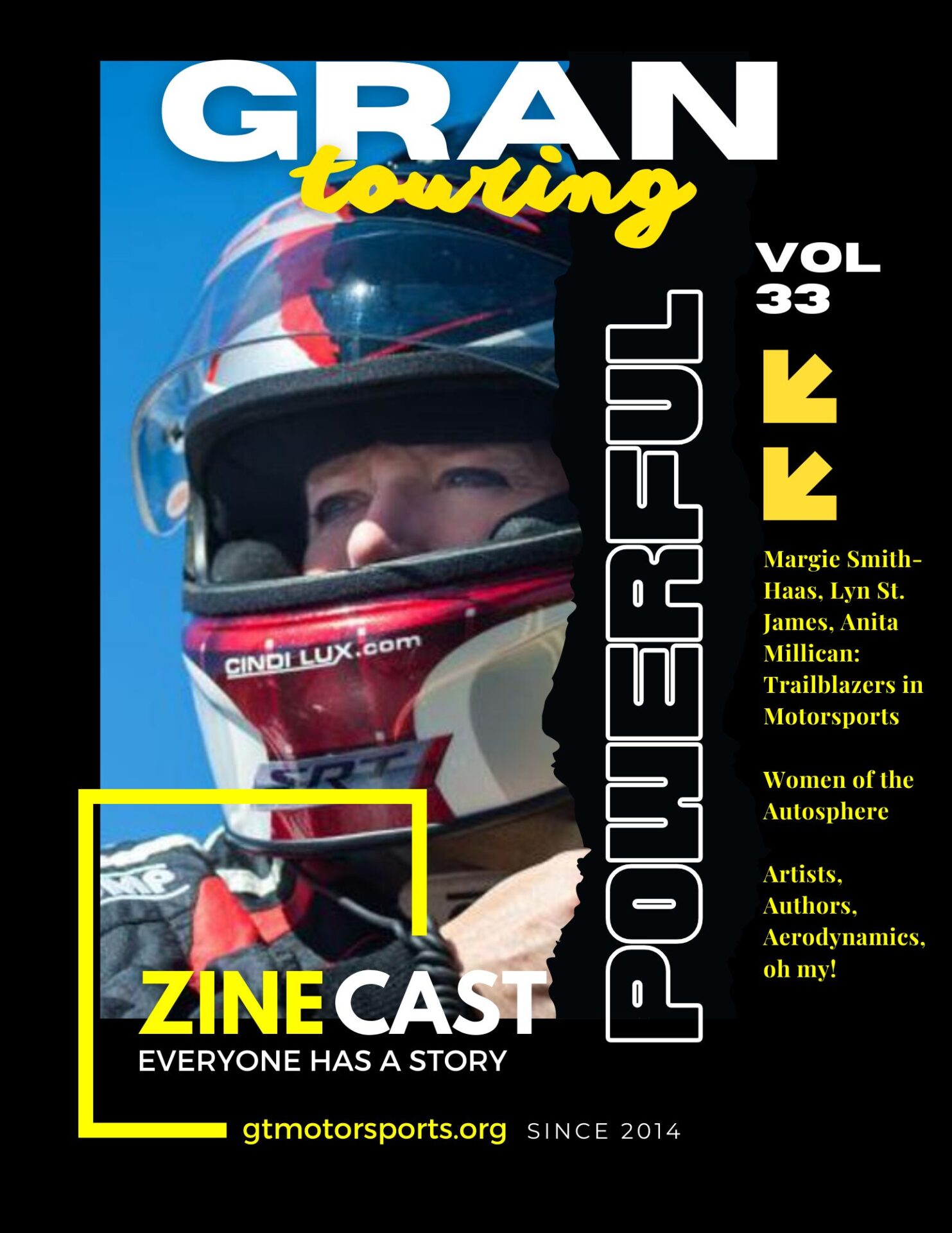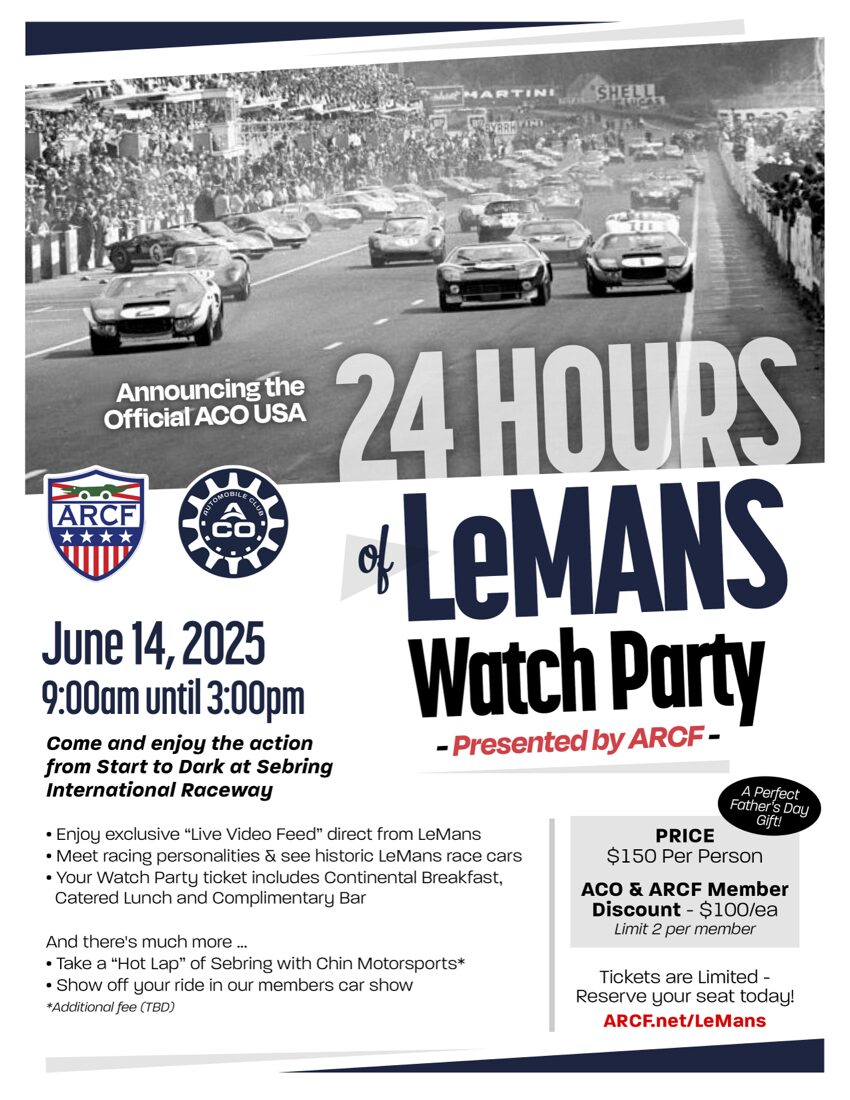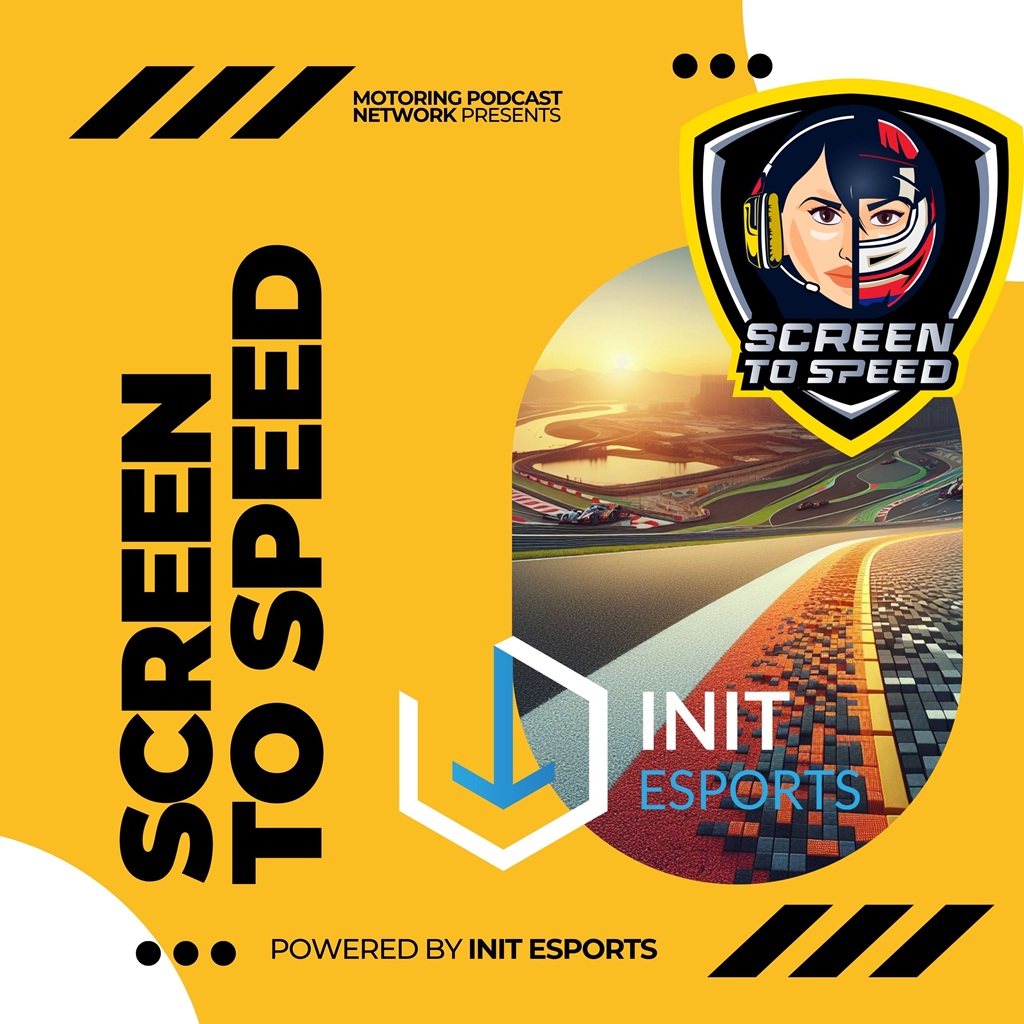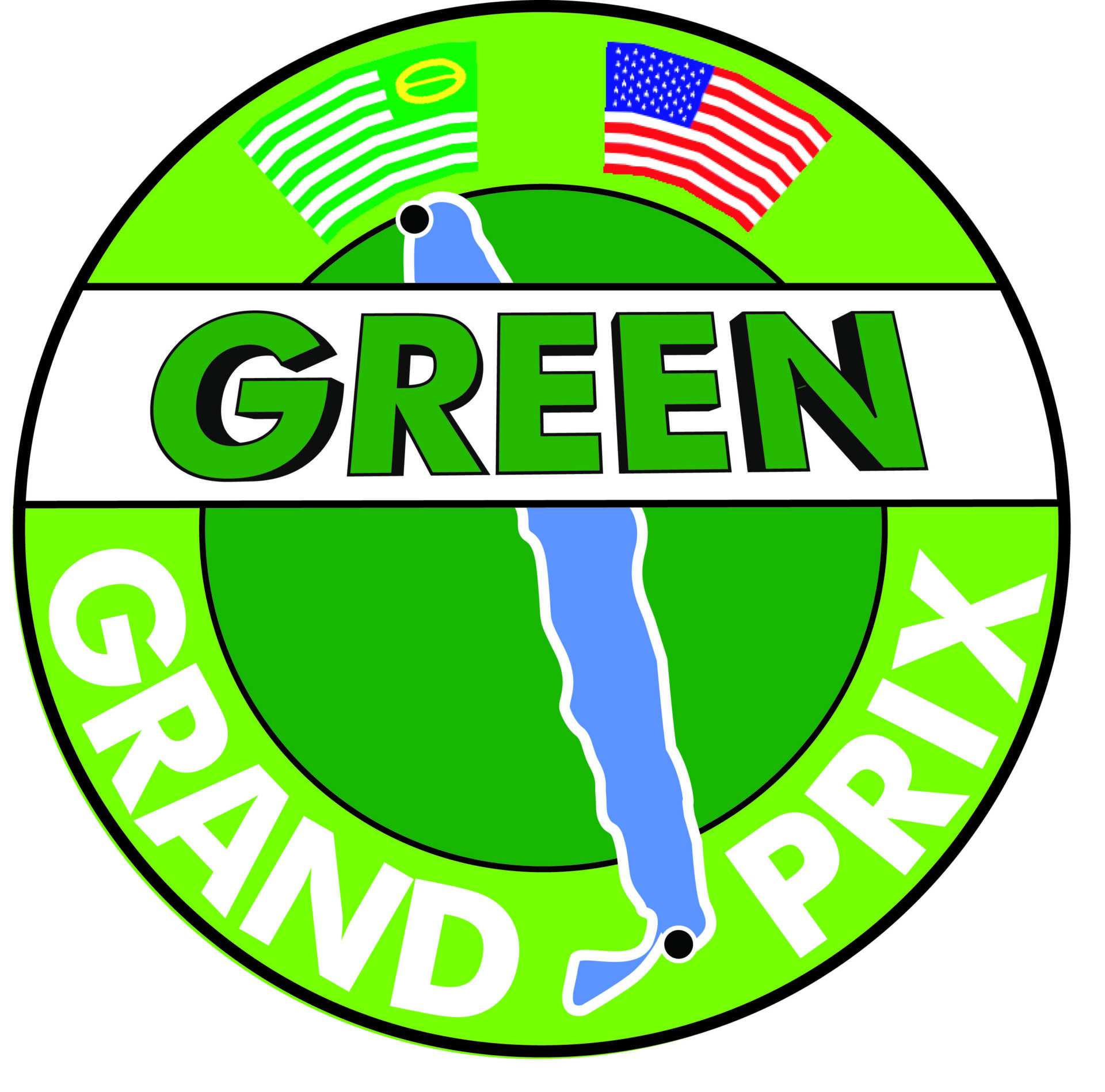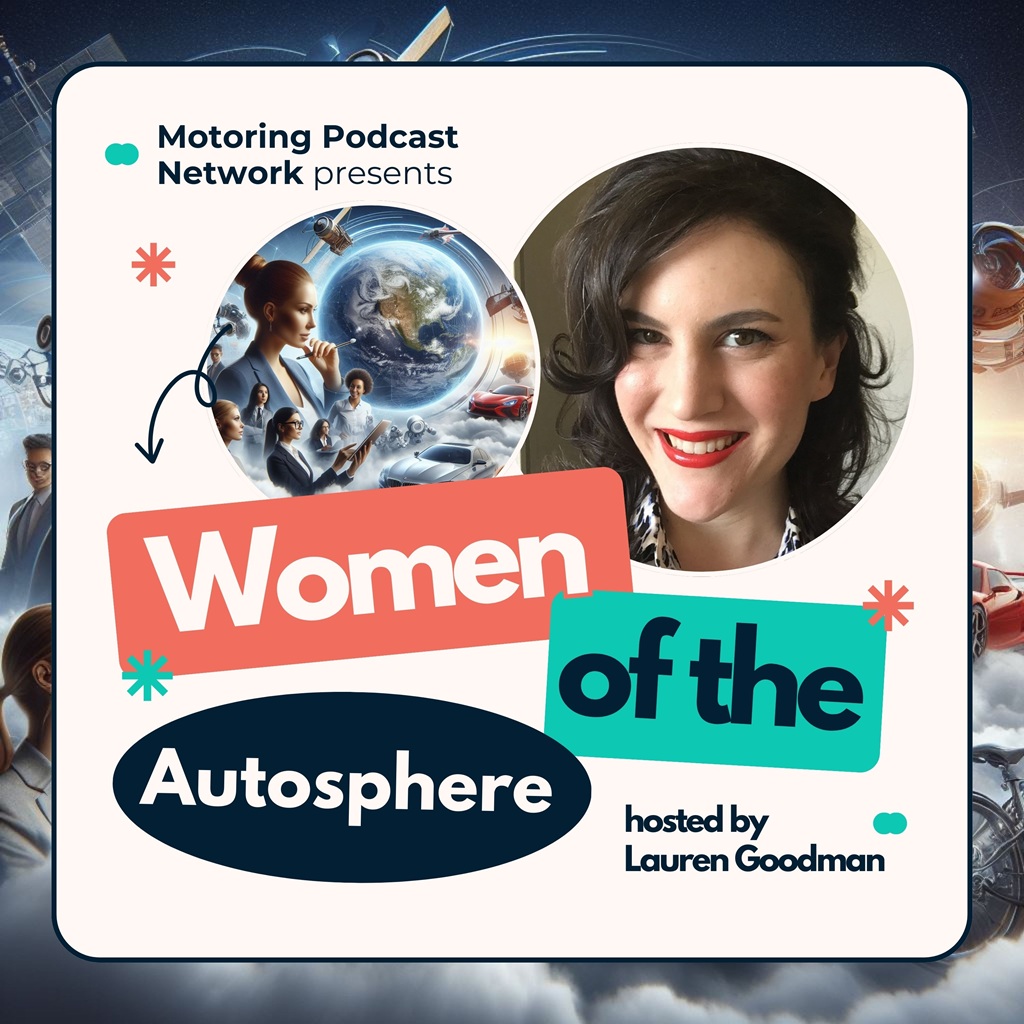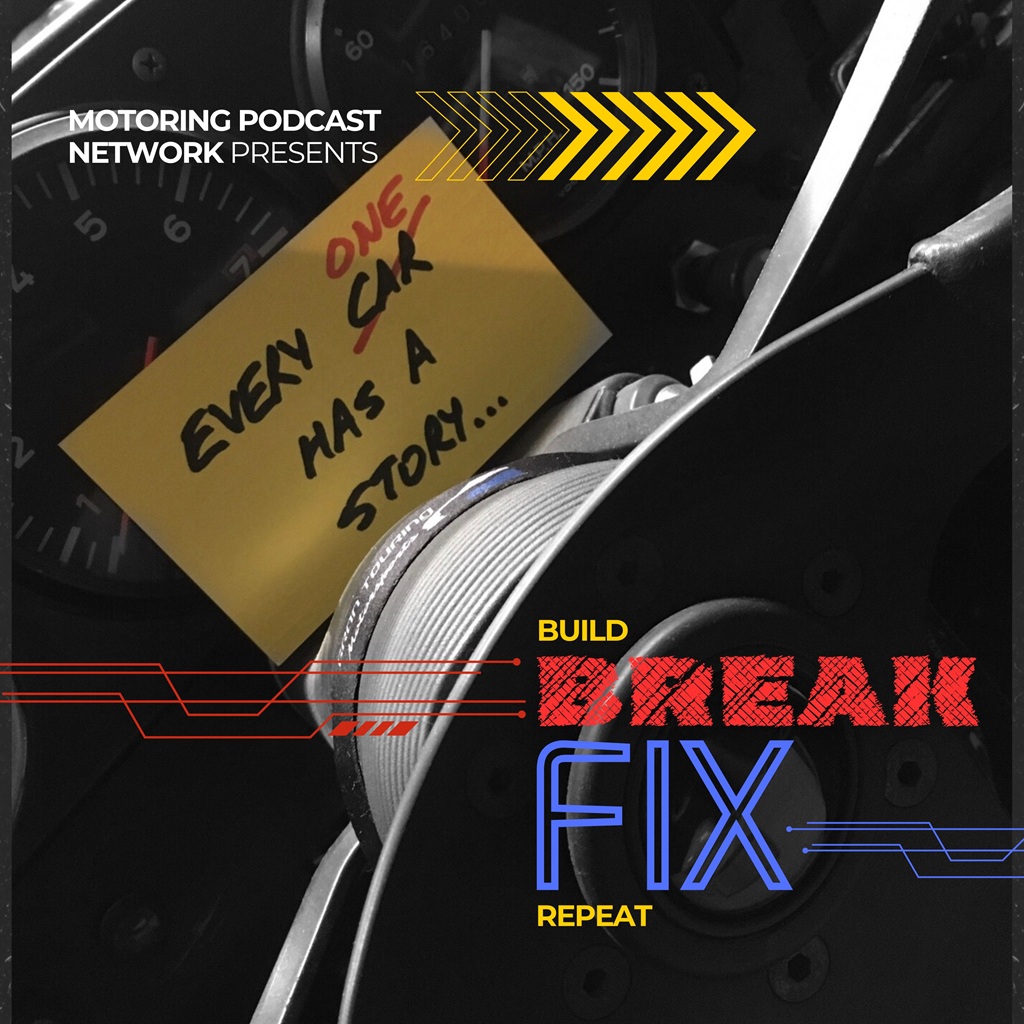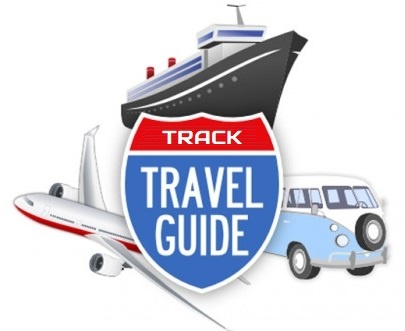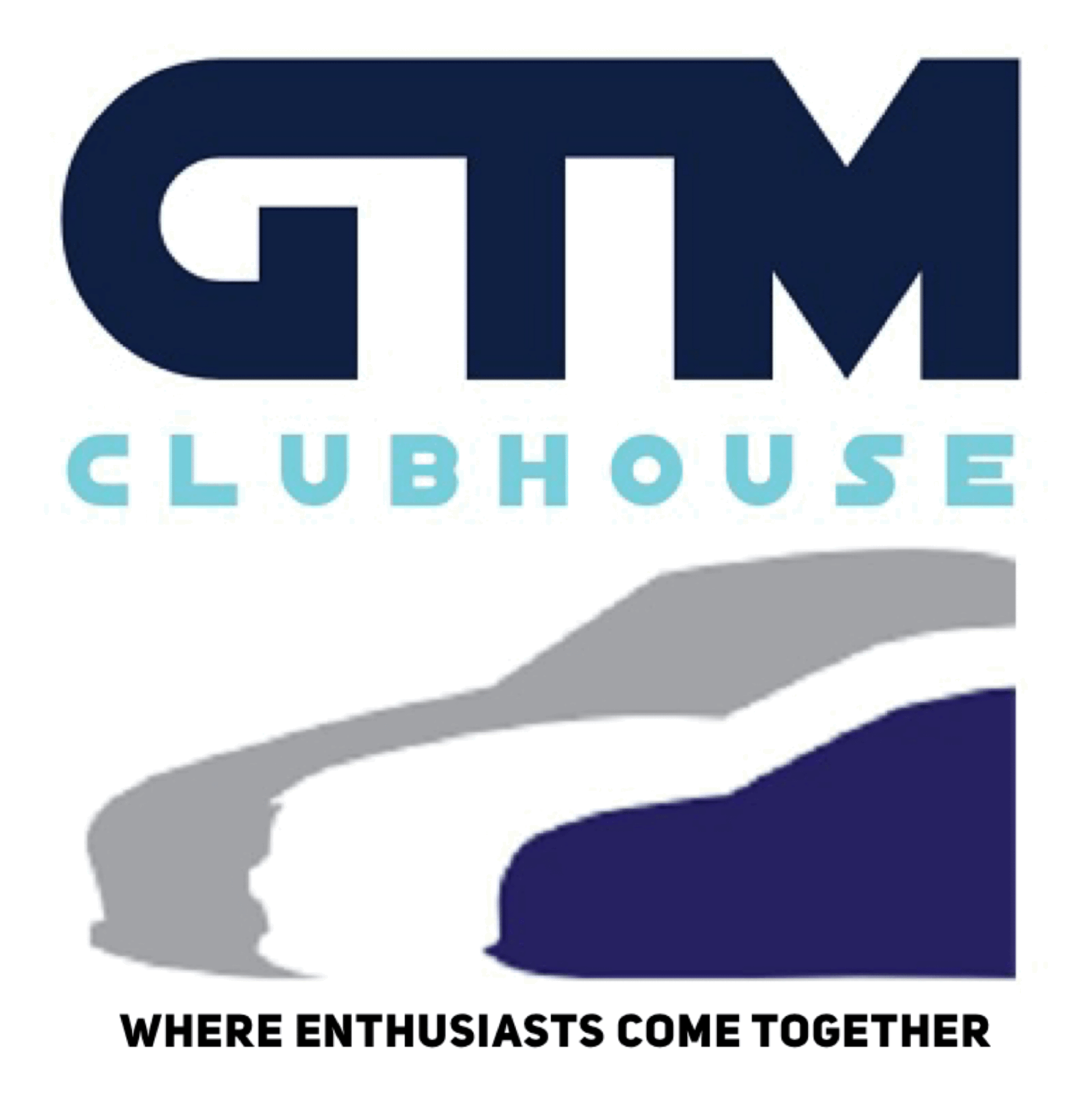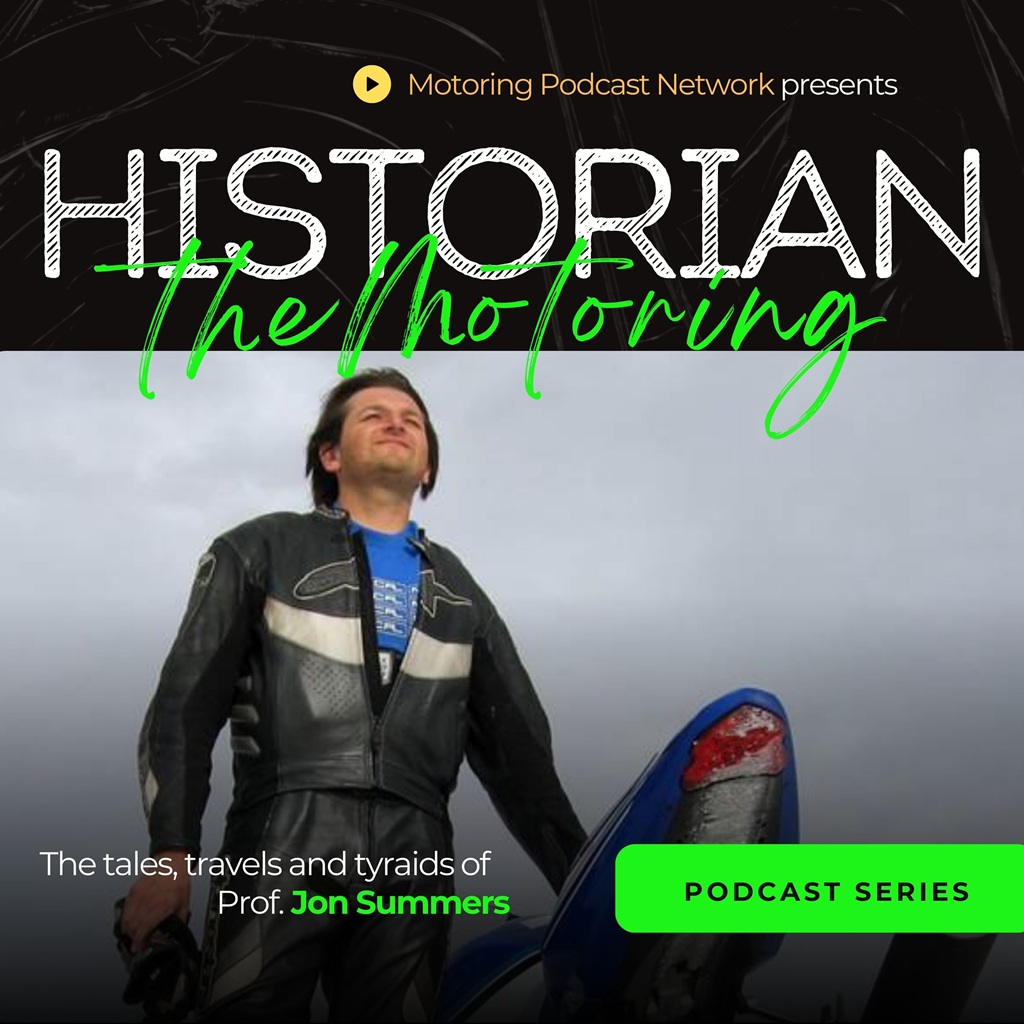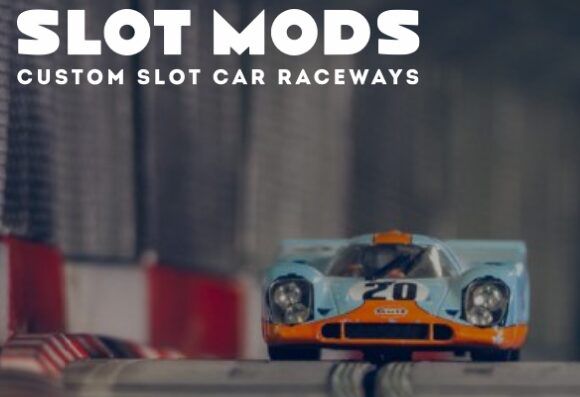For many of us, our stories begin with amateur racing in SCCA, and our guest is no exception. Full time-secretary and piano teacher by day, by the age of 26 she moonlighted in racing behind the wheel of a Ford Pinto which doubled as her daily driver. Quickly moving up the ranks, she fought alongside names like Haywood, Stuck and Ribbs in Trans-Am and IMSA. She would take home titles in races like the 12 hours of Sebring, 24 hours of Rolex and 24 hours of the Nürburgring.
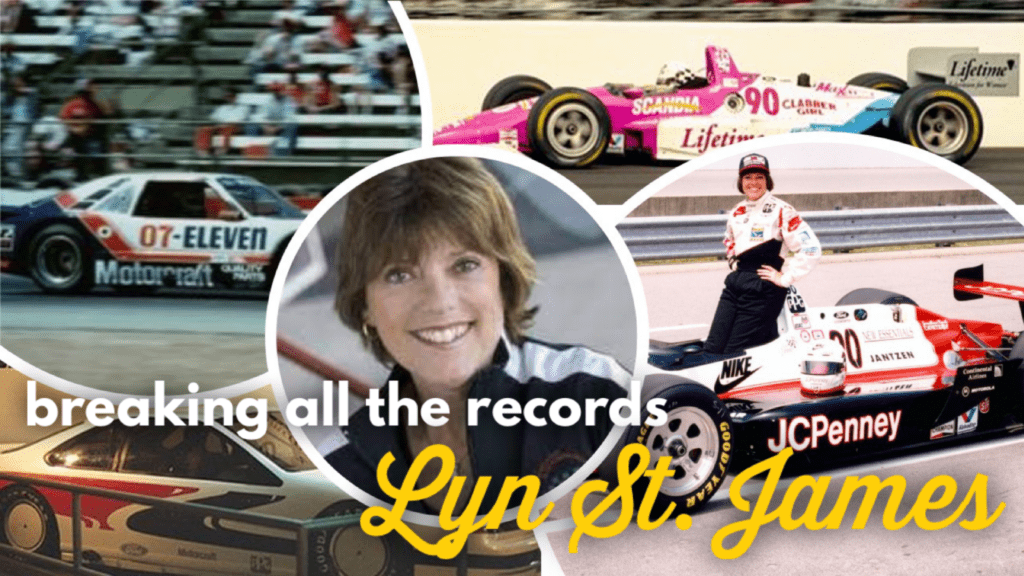
In 1992, the mold wasn’t just broken… it was shattered, and at the age of 45, proving that neither gender nor age matter in Motorsports – she entered the Indianapolis 500, earning the title rookie of the year. We are proud to welcome, the one and only, Lyn St. James to Break/Fix.
Tune in everywhere you stream, download or listen!
 |  |  |
- Spotlight
- Notes
- Transcript
- Highlights
- Learn More
Spotlight
Lyn St. James - Professional Race Car Driver for Women In Motorsports North America

1992 Indy 500 Rookie of the Year. Motivational, Keynote Speaker. Ambassador. Coach & Mentor. Broadcast Personality. Personal Appearances. Race Car Driver.
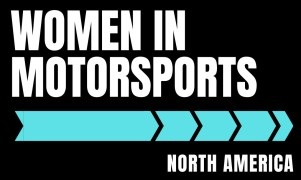
Contact: Lyn St. James at Visit Online!![]()
![]()
![]()
![]()
![]()
Notes
- Let’s talk about how you got into racing? What attracted you to it? Did you come from a racing family? What was your motivation?
- Rumor has it, you drove your Pinto it into a lake?
- The progression to Trans-AM – this era in racing was some of the best there was. 53 SCCA Trans-AM races with six wins, 62 IMSA GT races, with 17 top-5 and 37 top-10 finishes.
- In 1989 (and 1991) you went to LeMans – describe what that was like.
- The Road to Indy
- How did you go from TransAm/IMSA to Indy?
- You Finished 11th in the world’s most iconic race — and took home Rookie of the Year honors against a rookie class that featured Paul Tracy and Jimmy Vassar. Talk about the experience.
- Notably, the first woman to ever win the Rookie title.
- You were the first woman to go over 200 mph (227.32 to be exact) Let’s repeat that. First women to reach over 200 mph, in any car. – full stop. What was that like?
- After Indy – what came next?
- Women in the Winner’s Circle Foundation
- Lyn has written a few books, and is now a motivational speaker – what are some of the topics?
- Women in Motorsports North America
and much, much more!
Transcript
Crew Chief Brad: [00:00:00] BreakFix podcast is all about capturing the living history of people from all over the autosphere, from wrench turners and racers to artists, authors, designers, and everything in between. Our goal is to inspire a new generation of petrolheads that wonder. How did they get that job or become that person?
The road to success is paved by all of us because everyone has a story.
Crew Chief Eric: For many of us, our stories begin with amateur racing in SCCA. And our guest is no exception. Full time secretary and piano teacher by day. By the age of 26, she moonlighted in racing behind the wheel of a Ford Pinto, which doubled as her daily driver quickly moving up the ranks.
She fought alongside names like Haywood, Schook, and Ribs in the TransAm and IMSA series. She would take home titles and races like the 24 hours of Sebring, 24 hours of Rolex, and the 24 hours of the Nuber ring in 1992. [00:01:00] The mold wasn’t just broken. It was shattered, and at the age of 45, proving that neither gender nor age matter in motorsports, she entered the Indianapolis 500, earning the title of Rookie of the Year.
And tonight, we are proud to welcome the one and only Lynn St. James to Break Fix.
Lyn St. James: Well, thank you very much. Nice intro. Nice intro. I was like, my, I wonder who that is.
Crew Chief Eric: Well, thank you. And co hosting with me tonight is Tanya from our drive thru series. So we’re going to be getting down to some really interesting questions and diving into your background.
So like all good Break Fix episodes, let’s start with an origin story. How did you go from being a secretary and a piano teacher to racing? What drew you to that? Did you come from a racing family? What was your motivation?
Lyn St. James: I mean, no, I was just a race fan. I mean, I grew up in the sixties and the muscle car era.
And so everybody around my age, we’re all are into cars, you know, I [00:02:00] mean, that was kind of the GTOs and the Mustangs and the Chargers and Cougars. I mean, it was just the muscle cars. That was the big deal. And so, and I went to the Indy 500 as a spectator. With the guys from the gas station, but I kind of lived, I don’t want to call it a double life, but I mean, I went to a girl’s school.
I got sports because of that. This was pre title 9 and just for educational purposes. So you all know that this year is the 50th anniversary of the passing of title 9, which was actual law went into place that if you receive any federal funding. which all schools received some type of federal funding that you could not discriminate.
And then it was added that you couldn’t discriminate for sports. And so that enabled girls to be able to have sports. And again, this is the 50th anniversary. So I went to high school prior to that, but because I went to a girl’s school, I got sports and I’m absolutely convinced not just because I got sports, but because the most fearful moment of my life was when I was the first time on a field hockey team.
And I didn’t even know what field hockey was. And I’m like standing there holding the stick and trying to [00:03:00] figure out what the heck I’m supposed to do. And then all of a sudden, you know, I see these kids running after me or towards me. And I realized, you know, I got to stand my ground and I got to work.
And this was what sports was all about. And I think that served me very well throughout my entire development, you know, seventh or 12th grade that then enabled me many years later to get behind the wheel of a Ford Pinto. But anyway, muscle car era went to Indy, did some drag racing with my buddies. It wasn’t the right thing to do, particularly for a young female.
I mean, My mom sent me to girl’s school to become educated and self sufficient and independent, not to be out driving race cars. But I got married. I helped my husband build a business. We went to the 24 hours of Daytona together. I was, yes, the secretary and the bookkeeper. And you know, when you’re the co owner of a business, you do whatever it takes.
She’s a bottle washer
Crew Chief Eric: too, right? Yeah.
Lyn St. James: Yeah. You know, whatever. I mean, you sweep the floors, you, you know, do whatever, wash the windows. And so that’s what we were doing is we built the business. We went to the races in Florida, cause that’s where I was living then. [00:04:00] And I saw Daytona, the 24 hours of Daytona.
I saw the 12 hours of Sebring. To me, it was like all of a sudden I saw real people drive race cars and not super humans like at the Indianapolis 500. And so we became a members of sports car club of America. And found out that you had to go to driver’s school to get your competition license. Went out and bought a Ford Pinto, put a roll bar in it, a five point seat belt, a five pound fire extinguisher, which was required for all race cars and not just Pintos, if you know the story of the Pinto.
And it was my street car that I drove back and forth to work and then I went to driver’s school and it was my competition car in the beginning. The piano teacher thing, people pick up on that sometimes. That only lasted for six weeks and I got fired. And it’s a good thing to learn what you’re not good at.
That was what I was not good at was teaching piano. So I’m not a good teacher actually at anything because I’m very intense. You have to have a lot of patience as a teacher and I’m not that type of person, but anyway, kind of evolved over [00:05:00] time. You know, I didn’t come from the kind of family, but I came from a culture.
That made it acceptable and made it popular at the time that it was popular. So even though there weren’t a lot of females doing it, I was hanging out with the guys and it just, it was okay. You know, it was just okay to do it. And they let me behind the wheel and I was good. I was a good driver. I like to go fast.
Crew Chief Eric: If you read all the trade magazines and interviews you’ve done over the years, and you mentioned it yourself, the Pinto, right? It’s always listed there, but a little birdie told me that you actually drove that Pinto into a lake.
Lyn St. James: Yes, that’s true. My very first race after driver’s school, you know, they, they had good driver’s school and then usually the second school, there’s actually a regional race that same weekend.
So I got to enter that race. And of course I had a big X on my car. Cause as a rookie, you have to put an X next to your car number so that everybody knows to stay away from you. I lost control of the car as the car was passing me. You know, this was in South Florida. It was at. Palm beach international raceway, which just closed [00:06:00] literally.
They finally officially announced that the track is closed and they’re going to turn it into, I guess, to some housing development or something. But that was where I first started racing. And there was a lot of water down there. Turn two, three, and four went around what we thought was a pond. And I found out actually it’s pretty deep.
And so the car totally submerged. And it was my street car. So I had to flat tow at home, dry it out and, you know, drive it to work. Ran just
Executive Producer Tania: fine.
Lyn St. James: Well, it was not that easy. We had to really clean it out. I remember putting the motor for the windshield washers and the windshield wipers in the oven, and I think 150 degrees to get it to dry out and, you know, but it, yeah, it, it ran, I mean, uh, you know, we.
took spark plugs out and water came out, but you know, it was nasty. It was nasty though, because I ordered the car without air conditioning and I lived in South Florida. And so I would turn the fan on, try to get a little bit of air movement when I would be driving this thing to work and seaweed would come out of the vents, you know, to remind me of failure.
And you learn a lot more from [00:07:00] failure than you do from success. And in racing. You will have a lot more failure than you will have success. And it tests your dictativeness. It tests your fortitude of how bad do you really want to do this? And that was, to be honest, I could have easily given up after that first race because I was so embarrassed.
And I realized maybe this isn’t what I was meant to do. Maybe I’m not as good at this as. I think I am, you know, my husband at the time and is a really good guy. And he said, Lenny said, race car drivers aren’t born. It’s a trained skill. And he said, it’s just how hard are you willing to work? So that kind of was a good way for me to start to realize that I better know how badly I really want to do this because it’s going to be a lot of work, not all fun and games.
It’s not just, Oh, get a race suit and get a helmet, get all your gear and then get your car ready. And you get on the track. I mean, that’s just. There’s so much more to it.
Crew Chief Eric: Some of our previous guests, who you’re also friends with, happen to mention some other little tidbits about your past. So, you know, you’ve always really been associated with [00:08:00] Ford in a lot of ways.
When you look over your history and your driver’s resume, from the Pinto to the Mustang, to other cars and whatnot. And Dean Case mentioned making you part of the Ford Motorsports Enthusiast Group that he was a part of and helped start at Ford Motor Company.
Lyn St. James: Dean Case has a better memory than most of us.
You know, he remembers stuff that I look at. Look at him sometimes. I’m like, what? And he’s usually right. So unfortunately you don’t debate with Dean. You just sort of, sometimes you have to remember that he remembers stuff you don’t remember. When I got Ford as a sponsor, and I mean, I’m going to just fast forward a bit.
That was not Ford’s idea. I worked hard for three years, bugging the hell out of them. I’m absolutely convinced they hired me because they said that’s the only way we’re going to get control of this gal is because she’s going to keep bugging us unless we do. And then I told them the Pinto story. And to be honest, you know, they were not proud of that car.
They were like, could you leave that out of your story? I said, Hey, I’m telling you it’s there, you know, and it’s documented. And then not only that, it gets a lot of laughs. So, you know, it’s kind of like, it’s a great conversation piece. So there was no connection, the [00:09:00] Pinto to Ford, other than it’s the truth, you know, and that’s it, but they were not happy about that when I got forward as a sponsor in 1981, after literally three years of bugging him and they had announced special vehicle operations.
So they were really just getting back into racing after being out of it for the seventies. They were still formulating how they were going to do this. And so somewhere along the way, with the help of Dean created some Ford enthusiast program that they would ask me to make appearances and go to things, which at the time I’m like.
What? I gotta do what? All I wanted to do is drive the race car. I learned that they had other objectives that I needed to learn about and I needed to support. And I use that a lot with my training with young drivers or any driver trying to get sponsors. I say it’s not about what you want. It’s not about what you need.
You have to figure out how to satisfy them. What do they need that you can do while, by the way, you need their sponsorship so you can go racing. So it was a really [00:10:00] great learning experience for me to fulfill what Ford’s. You know, objectives were with why they were sponsoring me. And also along the way, I learned so much about how cars get built and used to go to the test track.
And I got to test drive a lot of cars. I used to, I worked with their engineers. I went to the design center. I went to factories. I got to see how car, you know, I mean, the whole thing was amazing and a huge learning experience about how the industry really works.
Crew Chief Eric: So we’re going to close the loop on this Pinto story because it does bring us into the modern times as well.
And Jim Jordan, who was also on the show, mentioned that he shared a Pinto with you in a 24 hour race where there were 25 different drivers. He says, we raced together, but not together, but using the same car.
Lyn St. James: Well, it wasn’t at a Pinto, it was at a Mazda. It was with Mazda. Yes. And so it was the 25 hours of Thunder Hill and it was so much fun.
I mean, I was all excited. I’m doing another endurance race. And then I, I show up and, and I’m like, so when’s my stint? And they’re like, well, [00:11:00] that’s not until tomorrow. Like what? And then I put my suit on and I did my stint. And then I’m like, what’s my next shift? No, you only get one. Like you’re kidding. So it was a fun, but weird experience to have 25 drivers.
And one race car in one race, you know, everybody only gets one stint. It’s like you just get warmed up, you know,
Crew Chief Eric: Lynn, let’s go back to the timeline here a little bit. You moved away from, let’s say, amateur racing SCCA up into trans and more into the program side of the world. How did that transition occur?
And just to remind our listeners, this was the. Era in racing where there was some of the best there was, you know, some of those names that we listed in the intro is just a very, very short list of very famous people in that list to include yourself. Let me just add some stats to this to level set.
Everybody does this and you had 53 SCCA Trans Am races, 6 wins, 62 IMSA GT races in this time period, 17 top 5 and 37 [00:12:00] top 10 finishes. Just to kind of round out that era. How did you get there and what was it like?
Lyn St. James: I had been racing SCCA, my husband had a Corvette, so I got to run a Corvette a couple times in IMSA in the Camel GT series.
So I got to drive a high horsepower big car. In 1981, actually before that, the Kelly company, Kelly Services, which used to be called Kelly Girl, they sponsored a series in IMSA. called the Kelly American Challenge. That’s when I showed up on the scene in the IMSA series. I was actually quite successful that first season.
Then I kind of scrounged around getting rides in various endurance races. Then I got Ford as a sponsor in 1981 in the Kelly American Challenge series. And Ford chose to start out with a Mercury Capri. That first year that that was the first one, which is essentially a Mustang, but with a Capri body on it, I did that for two seasons.
This is when I learned that Ford was going to decide where I was going to race. Not [00:13:00] me. And then that’s when they said, okay, we’re going to put you with Tom Gloy and you’re going to run in the, which was at the time SCCA Trans Am series. That was my first season in Trans Am. A completely different experience, completely competitive, meaning the top drivers, one hour races, no pit stops.
It’s not like endurance racing. I mean, an SCCA, they were all 30 minute races, very short, no refueling. I mean, no pit stops. You just, you know, go to your thing. Then you get into IMSA and now you’re running these endurance races where there’s multiple drivers, longer stints. You had to learn how to make pit stops, refuel.
I mean, the whole thing, which was great experience. And the other thing is that I really learned how to qualify because there they had very short qualifying sessions where in endurance racing they have, you have to have a long enough session that all three drivers or all four drivers get to actually get a qualifying time.
There was just a lot of learning to do. And that’s essentially every season after that, whether it was Trans Am or in the IMSA Camel GT series, Ford decided what team I was going to [00:14:00] be on, what series I was going to race. I was blessed. These were all one year contracts. I was never on a long term contract.
So I was always fearful in negotiating that next contract and then trying to figure out where the heck I was going to race. But loving the 24 hours of Daytona and the 12 hours of Seabrook, I was always hoping that I would get to at least be in those two races because I really do love endurance racing.
And of course, because I lived in Florida and I went to the IMSA races, I saw drivers like Hurley Haywood and Peter Gregg and Hans Stuck and Jim Busby, Al Holbert, and you know, all of these world class drivers. And I mean, the dream was one day to be on the racetrack at the same time with those drivers.
But when I wasn’t on the racetrack, I was watching them because that’s how I would learn. I would watch their lap times. I would go and observe in their paddock area, how they handled and managed their team and how they set their garage up. How do you learn all this stuff? I even read a lot of books about it.
But you will learn most by watching and observing. It’s like going [00:15:00] to class, you know, you, you get to go to the paddock and watch how the pros do it. And not just any pro, but how the best, you know, I always watch to see who was the best and that’s who I would pay attention to that way they do things.
Peter Gregg, invariably, every time there was a practice session or a qualifying session, his car was the first in line to go out. I mean, he was ready. That makes a statement. If you’re still trying to get your car together when qualifying starts, which you see a lot of people that way, I mean, they’re still thrashing, trying to get their car on the pit lane to even go out or get them in their own pit.
Peter was always First car in line, it’s just something that I remembered, you know, so you always got to be ready
Crew Chief Eric: amongst all the drivers in the paddock, who would you say were your closest friends at that time? And maybe who are your biggest rivals?
Lyn St. James: Well, they were all rivals. One of the ones that was, I felt like we were buddies with Doc Bundy, which of course, then a few years later, he did a very bad thing at Riverside and caused a horrible crash.
I got along with everybody. I [00:16:00] got along with just about everybody. Wally Dullenbeck Jr. We had a good time together. You know, I mean, he was a kid. I was old enough to be their mothers in some cases. I mean, seriously, I was definitely a little aged out compared to them, but I got along with most of them. I mean, seriously, Scott Pruitt was great.
Tom Gloy and I, you know, but we became much more friendly when we were no longer teammates, or we were no longer competitors at the same time.
Crew Chief Eric: When you were going through this, were you being coached or were you learning by the seat of your pants, by lead follow or driving by feel? This is still the era where data wasn’t nearly as prevalent as it is today for drivers.
Lyn St. James: We had no data except for our butts and our fingers, you know, on the steering wheel and our brains. We didn’t have coaches back then. We didn’t have driver coaches like they do now. So, and we didn’t have spotters. You were on your own out there. I literally would pick the brains of drivers as much as I could, my competitors and my teammates.
And I can tell you one person that was hugely, hugely [00:17:00] impactful on me was Bob Riley. Bob was a car builder, an engineer, he’s a chassis expert, he was hired by Ford on occasion, you know, sometimes he was working for Chevy and sometimes he was working for Ford, but if he was at the track, I would find him and pick his brain and start talking about.
The, what the car was doing and what I was feeling. And then sure enough, I’d find out that he was out on the track, watching corners. He wouldn’t tell me that automatically. I would eventually, you know, we’d come out in our conversation, but he taught me a lot by asking me the right kind of questions about what I was feeling in the car, and I have to learn how to communicate.
So that an engineer in this case, Bob Riley and any engineer could understand what I was talking about, but it was learn as you go. You know, I was like a sponge. I was absorbing information like crazy. I mean, I remember one time I saw a picture. Actually, I came across just a little snapshot. Jim Busby was somebody that I just, I was like, Oh my God, the guy is so good.
And I was on pit lane in Pocono and I was really frustrated. The car is a piece of junk and I was [00:18:00] trying to figure out what was wrong and you know, yada, yada. And so I saw Jim and I walked up to him and I said, Jim, hi, I’m Lynn St. James, which means nothing to him. But anyway, I said, if you’ve got a couple of minutes, he goes, yeah, what do you need?
And I said, can we just walk on pit lane, walk down pit lane? And will you point out features? Of every race car that we’re going to walk past and tell me why that car is good or why it’s not good just by visually looking at it and I learned more in that 10 minute walk that I learned in the whole season because of learning about where the center of gravity was, where the driver’s seat was, where the wheelbase was, look at the aerodynamics, look at the ride heights.
It was like a walking encyclopedia experience.
Executive Producer Tania: You were doing competition, so it’s race day. What are you doing in between race day to practice? Were you doing any and every track event that you could possibly find? Or were you the seat of your pants every time and you’re absorbing and you’re learning, you’re trying new things race day?
Lyn St. James: We had no simulators back then either, dear. So we’d get track maps, wonderful [00:19:00] track maps. I would always try to get in a day early. You know, usually it was a Friday, Saturday, Sunday schedule. I would make sure that I got there on Thursday and I would walk the track or I would beg whoever was the track owner or the track promoter or the track maintenance person, can I take my rental car around?
I promise I’ll go really slow. I tried to at least do that on the new tracks that I’d never been to. And that was in the beginning in those early eighties, you know, I hadn’t been to any of them. I get previous years programs because a lot of times you would have a race program and there would be a driver like, you know, Jim Busby or Derrick Bell, who would describe the track and so I’d read their track descriptions to try to learn the track.
It was definitely I mean, you had practice qualifying. I mean, you had sessions, right? But hopefully by race day, you had it pretty well figured out. You were on your own. You were on your own. All of the infrastructure, which I, I admire. I mean, I used to get frustrated because I’m like, as I got to know other athletes, you know, I, I’d meet other tennis players and [00:20:00] swimmers and golfers.
They all had coaches. They all had trainers. We didn’t have any of that stuff. I’m like, that’s one of the reasons why I started my driver development program in 1994, is it’s like every race car drivers on their own. Today the world is different, but back then, even in the nineties, it wasn’t. And so I said, well, you know, you have to get better.
You have to learn new things. You have to get new information,
Executive Producer Tania: and you need that seat time. And using your example, if you got access to a swimming pool, you can go every day and practice for hours. But it’s really hard to have a racetrack in your backyard.
Lyn St. James: You used to drive me crazy because of that. You know, I mean, I played tennis, you know, locally just for fun, but it was still competitively and, you know, you go out and drill and practice and get ready for a tournament and in racing, I mean, it was just.
You know, you prayed that you might get a test day the day before the race weekend, you know, because obviously track conditions change, weather changes, you know, so if you go at the different time of the year, it doesn’t help you much usually, but it’s a very frustrating sport even today because the cost, I mean, even though [00:21:00] simulators help tremendously, if you could get into them and.
Know how to work them, but no, that’s true. Yeah. I mean, seriously, you’re right, Tanya. I mean, it’s a very difficult sport, which is what I also tell up and coming racers that maybe race go karts or quarter midgets or legends cars or mini sprints or all the different. And now they have these great ideas about what they want to do.
It’s tough. It’s really, really tough. You know, the, the gender thing is. First of all, it’s the one thing you aren’t going to, I shouldn’t say that, but that you aren’t going to change. And so you have to focus on the things you can change. And if you don’t have the funding or you don’t have the capability, if you have a full time job and you don’t have the chance to go, even if you had the money, you can’t go test, you know, you can’t go do a test day.
And these track days and all those wonderful things that are available now, they just, they’re just, it’s just hard. It’s just a hard sport, but it’s so rewarding. That’s why when you get a good lap, Just a good fricking lap. You are like [00:22:00] elated, you know, and you know, you put a bunch of laps together or you get a good qualifying and then you actually get it about the time you’re about ready to give up.
You get a good race result and you’re back in again. You got hooked again. They
Crew Chief Eric: often draw that parallel with. Playing golf, you know, 17 terrible holes. And then you have that one good one. That’s what keeps you coming back.
Executive Producer Tania: Yeah. We’re going to circle back on a couple of things you just hit on there, but obviously you’ve hit lots of different tracks.
What is your favorite or least favorite, or is there a track you haven’t been able to go to that you wish you will one day?
Lyn St. James: Hmm. That’s an interesting question, actually. The last part there, because I don’t, I mean, I’ve been to Austin, but I haven’t been on the track to race it, even though I got a hot lap around it with in one of the Skip Barber cars.
And I’m like, where the hell am I? I mean, it was like, the corners are also similar, you know, visually. Been on that track. Have you? Yeah. And I mean, I was like, God, I think I’d have a hard time just figuring out where I am, you know? Well, my favorite road course is Watkins Glen. I mean, that is completely, and they’re [00:23:00] running it.
You know, and I’m so soon, I just love that track, the flow. And of course this was before they put the chicane in and it’s still the flow of that track, the rhythm, just love it. I absolutely love it. The hardest track that I never felt, right. I never, ever felt like I got the right lap. Not one damn good lap was a serious point.
You know, Sonoma. It’s just so hard. The off camera, the elevations of blind corners that, you know, it just about the time you think you got one corner, right, you’re into that next corner. And then you’re like. Screwed up. I never felt right there. Other than that, I mean, I got to run Nürburgring. I got to run, you know, Le Mans.
Yeah, I have gotten some really, really great, you know, great racetracks that I’ve been able to be at and Daytona. So anyway, I don’t really have one out there that I’ve got. Oh God, I wish. I could still do that. I mean, the only thing I have left that I, that I really want to do, but I don’t know if it’s going to be in the cards is to set a record of Bonneville.
I got to run Bonneville once in 2017 and it is, it is not easy. It’s like, Oh, what’s the big deal? It’s just going straight now. It’s rougher than, I mean, [00:24:00] it’s like really, really rough and rugged. I mean, you’re bouncing around. And so the car is bouncing around and your eyes are very hard to visually have a perspective of where you are.
And the bouncing is it’s brutal. It’s actually brutal.
Crew Chief Eric: So I want to stitch together a couple of things before we transition again through the chronology here. And it has to do with, it has to do with Watkins Glen as a matter of fact. And as I look back on this time with very fondly, because it was in my formative years between IMSA Trans Am and Group B, that’s where I fell in love with motor racing, right?
And they’re still my top two things. And some of those drivers transitioned between the two in that era. So my question is this. I remember Hans Stuck in the rain in the Audi’s at Watkins Glen. We look back on that and you see the old videos and this and that, and you know, they talk about the unfair advantage and you put it in today’s perspective, it’s probably on par with the drama drive to survive and all these wonderful shows that people watch.
Was it really like that when you guys were competing against the Audi’s? [00:25:00] Was everybody so upset about it? Was it really that earth shattering?
Lyn St. James: It’s awful. You would be hanging under your car in a corner. And then they just go driving by, you know, cause you got that all wheel drive and it would be like, you would just cuss the hell out of everything.
I mean, I could have killed Hurley and stuck, you know, because it was like, Oh, I can remember metal lands particularly because you know, when you get in these temporary circuits and, and so it was maddening, it was totally, it was, it was brutal and maddening because it was an unfair advantage. I mean, it completely, I mean, there’s turbos and there’s normally aspirated that are racing against each other.
They have different power bands. But you know that all eventually it evens out and there are certain tracks that are handling tracks, certain tracks that are more high speed tracks if you have a handling car versus, you know, one versus the other. But it eventually evens out when they had that all-wheel drive bullshit.
I mean, that was like, that was never gonna even out. There’s no balance
Crew Chief Eric: of performance there, right?
Lyn St. James: No. Oh, of course now, yeah. I mean there’s the, that, that’s a whole different thing the way the rules are. I mean, God, [00:26:00] I’d hate to have to run a team right now because every week they change the b o P, you know, Yeah, back then you were stuck, you know, you were stuck with what you got, the way the roles were.
They didn’t change the roles that much throughout the year. And if they did, it was usually to your disadvantage. But that whole Audi all wheel drive thing was, it makes me just live in thinking about it again, because. We struggled so hard. God, it was awful
Crew Chief Eric: to add a little levity to that. I will never forget the summit point race.
It was just before they got banned. And I believe Hans was pretty upset because people started blocking. They put their elbows out. They’re like, we’re tired of this. So he starts passing people in the grass.
Lyn St. James: Yeah,
Crew Chief Eric: come on, man.
Lyn St. James: Well, you know, it’s like I got to race. This is not maybe a good analogy, but it makes me think of it.
We just said that because I got to drive for the first time and race a prewar. You know, what is this like 1912 national? And I remember learning. You know, how to do the clutch. And I mean, we were driving and it was at Sears point or, you know, Sonoma. So we’re driving [00:27:00] on the hill there. Try it. I’m trying to learn to drive this thing, you know, and I just remember the guy that owns it, Brian Blaine said, he said, don’t worry about it.
If you go off course though, he said, don’t try to correct and come back on. He said, just ride it out. It’s nothing more than a tractor. So, you know, It’s like if you go off course and one of those all wheel drive, that’s, you know, it doesn’t really matter because it’s really just, it’ll drive on, it’ll, those wheels will get traction anywhere, you know, even if it’s off of the grass,
Executive Producer Tania: just stay out a little longer, do some landscaping for us.
Lyn St. James: Yeah.
Executive Producer Tania: Yeah. But, uh, jumping back into the chronology. Uh, so in 1991, fast forward a little bit. So you went to the mall,
Lyn St. James: but see, I went to Lamont 89 and that was. At that time of my career, that was the highlight of my career. I mean, to get to go to Le Mans and it was, I didn’t know that they were going to completely rebuild it right after that.
So in other words, where they put a chicane on the Mulsanne straight and they built these new garages and they built this new structure and, you know, everything changed in 91. But at 89, [00:28:00] I got to run with Gordon Spice and Ray Bellum in a Cosworth Spice chassis. And it was the old track and the old pits.
And, you know, I felt like I was in the movie, you know, Le Mans, because it was just the way it was in the movie. We ran 16 hours. I got to get a lot of seat time. It was perfection other than we didn’t finish. And I loved it. I mean, I loved it. The 91 was pretty awful to be honest. It’s not one that I, I, I don’t like to even talk about it because it was just
Executive Producer Tania: this time it was an all female team.
Lyn St. James: Yeah. And I mean, there was nothing wrong with the all field. Desiree was fabulous by the way. I think she’s one of the most talented male or female race car drivers that I’ve ever met, but that was what Desiree and Kathy Mueller. But it was the, the car was a piece of shit, clearly. I mean, and the team was lost.
It was a Japanese team. They were clueless. The car was not set up at all. It was not prepared to run a race period, yet alone the 24 hours of Le Mans. You know, the two gals, I mean, we were, we were great, but the car was just.
Executive Producer Tania: Yeah, because I saw that ended in a very short number of [00:29:00] laps.
Lyn St. James: Yeah. Yeah. I mean, I didn’t even get suited up.
I wasn’t gonna, I mean, it was not worth it. But Des was absolutely relentless. She was convinced she was going to get that car to work. I mean, the brake pedal fell off. I didn’t lose the brakes. The brake pedal fell off going down after the at the, at the end of the Mulsanne straight. Oh, God, it’s just makes me
Executive Producer Tania: so they wouldn’t have been, you know, the first ones out on a qualifying session in a different race.
Lyn St. James: I mean, it makes my blood boil just thinking about it, you know, it really does. So anyway, but I was glad to go back because it made me appreciate 89 even more, you know, but it was very pristine and clinical and kind of, I don’t know, it was very much different.
Crew Chief Eric: Do you look forward to next year’s 100th anniversary of Le Mans?
Lyn St. James: Well, I do. I look forward to celebrating it this year because we’re going to celebrate it at Monterey Historics and we’re going to celebrate it at the Pebble Beach Concourse. I’m excited to be. There to help celebrate, you know, to be part of the celebration in any way, shape or form, and [00:30:00] to see all the cars.
I wish my spice could be there, but it’s not. Yeah. The next year being the hundredth anniversary is very, very exciting. I remember the hundredth anniversary of the Indianapolis 500, and that was a huge deal, you know, and they actually had, I think three or four. They had the hundredth anniversary of the building of the track in 2019.
Then they had the hundredth anniversary of the first running of the 500. And then they had the hundredth running because of obviously those years that we had a number of different hundredth anniversaries and Indies. And I think Lamar will have another one too, because this was their 90th running, I believe.
So another 10 years, there’ll be another hundredth. So it’s kind of cool to be a part of something or to be around when something is being celebrated.
Crew Chief Eric: I think that’s a perfect segue into our next set of questions because you are part of the Indy 500 history. You’re part of those hundred years. So how do you go from Trans Am and IMSA into Indy?
What inspired you to go there? There’s a lot of congratulations around what happened, [00:31:00] but I haven’t seen too much of What was the road to get there? What got you there? Did you look to somebody like Janet Guthrie, who was the previous woman to run the 500 as your inspiration, or was it something else that drove you to Indy?
Lyn St. James: No, I mean, I, I remember watching Janet, but you know, I was racing in, in SCCA back then. I hope so. And I just remember I was real happy doing what I was doing and she didn’t look like she was having a really good time to be honest. And they didn’t want her there. I mean, there was the coverage I saw. I mean, I’m having a great time, you know, I got a lot of friends.
I look forward to seeing my friends when I go to the races, you know, and, and that was not her experience at Indy. So that was not a, That didn’t leave a really good, you know, positive image in my mind, you know, after doing Daytona and winning at the 24 hours and winning at Sebring. And then I started doing the TV coverage at IndyCar because I was done Trans Am.
And we were the same weekend. Often I was actually working for ESPN and ABC and doing that. And I, so I got to hang out a lot with the IndyCar teams and the cars. I became just [00:32:00] mesmerized with those cars. I mean, when you get up close, it’s one thing to watch them, you know, when they’re going 190, 200 plus miles an hour going by.
But when you’re in the pits where they make pit stops, you know, I was a pit reporter. And when you’re in the garage and you’re around them, you know, the sophistication level back, back in the eighties. And I thought, you know, I just want to drive an Indy car. I mean, I’m a race car driver, prototypes and the cars that I’m racing are pretty cool.
But, you know, this is a lot cooler. And so I just want to drive an Indy car. I mean, seriously, that was it
Executive Producer Tania: want to go fast.
Lyn St. James: I want to drive an Indy car. I want to know what it’s like to drive what I’m going to call a perfect race car. And so I spent probably two years talking to team owners. Can I just, when you guys are testing sometime, you know, it doesn’t work that way.
Leave the keys in it. Just turn around. Exactly. It doesn’t work that way. And so, you know, doing a test, they like big money to do that, you know, I mean, for a [00:33:00] driver to do an IndyCar test. is expensive. So it was really like, I don’t know what the hell I was thinking, but I really kept. And so finally I ended up talking to Dick Simon.
I talked to him a lot. I would talk to him almost every race, you know, and they may, Hey Dick. And, you know, this is a fairly long story, but it’s the truth. I was doing TV coverage at Tamiyami, which was the last race of the season. And it was actually the race where Al senior beat Al junior to win. You know, the championship was a very big deal.
I also owned an auto parts. Shock absorber business. And I remember Sunday night getting back to my office down in South Florida and the phone rang and it was Dick. He said, Hey kid, you said you wanted to drive an IndyCar be at Memphis tomorrow. And that was about the end of that conversation. I’m like, what, what, what, what, what?
I didn’t even know there was a racetrack in Memphis. I’ll see you tomorrow. He hangs up. I get an airplane ticket. I go to Memphis. I rent a car. I find this damn racetrack that I didn’t know existed, which is basically it’s a drag strip with a little return route and the IndyCars test there sometimes. He was on the way back to the shop at [00:34:00] Indy.
He had a rookie test scheduled, but he also had Rolls cars and other cars on the trailer that he’d brought into Miami. And he also, I found out later, he had miles left on his Cosworth because you had to. Send them back to Cosworth to get rebuilt after so many miles. Well, he had miles left on that engine, so it wasn’t going to cost him anything.
He gave me that chance. And so I showed up, he’s like, hi, how you doing? And then I had my race suit and everything, but we weren’t going to pour a seat or anything, so now we’re trying to get me fitted in the car. You know, we’re using rags and jackets and, you know, anything we could get a hold of to try to get me fitted in the car, the kid working on the car could have had that day off.
If I hadn’t been there as the test, he was in charge of that car, but that car wasn’t supposed to do anything except Dick said he, he let me have some laps. So, while we’re getting fitted in the car, I’m thinking to myself, you know, this is such a cool opportunity, but I could get the feeling that this guy was like, not necessarily excited about having to work that day, but then he says to me, Hey, he [00:35:00] said, were you ever at Snedderton?
I was at Snedderton. One day, about four years prior, when I tested the Argo GTP car, and I went, yeah, yeah. He said, I was there that day. He said, you ran good. So magic, in my opinion, this kid knew me, knew that I was at least a decent race car driver, maybe a good race car driver. And so he was in the game that day.
He could have made my life miserable, but instead he worked with me. All day. And Dick told him, he said, put 10 gallons of fuel in, let her run 10 laps and then bring her in and just keep doing that. And then Dick left, he had meetings or something and he left. I, I started out, I’m sure horrible, but I mean, I got to run almost the whole day.
I would do 10 laps and I would come in and he’d put fuel in, I’d go back out and do 10 laps. ’cause that way it didn’t change the weight of the car. In other words, the car was pretty stable. And Dick came back and when he came back, By then I was actually running pretty decent. When I got out of the car, Dick said to me, we can do this.[00:36:00]
He didn’t say you can do this. He said, we can do this. And I’m like, what? And so that was what changed from, I want to drive an IndyCar to, oh my God, I got a team owner who’s willing to give me a shot at this. It was in 1988. And that’s when I started the whole mission of trying to race an IndyCar. God knows I did not want to start at the Indy 500, but when I was pitching sponsorships, that was the only race that anybody wanted to talk about was the Indy 500.
I was in. I felt so good in the car. It’s the first time I didn’t have to wrestle with a car to get it around the track. I mean, hell, I stopped. I mean, I put the foot on the brake and the car stops. I literally, the first time I had to drive, the car came to a stop on the straightaway because I was so used to the Trans Am cars and the heavy cars that, you know, you, you have to break back there to get the car slowed down up there.
And instead I break back there and then the car came to a stop. I’m like, holy shit, I have to put it in first gear and drive back down to the corner. But it was beautiful. I mean, I felt so one with the car and it was just great. And not only that. At the end of the day, [00:37:00] after we got all done and Dick said that, he said, Hey, come on, join us for dinner.
He took the whole team to dinner. It was just the family atmosphere. When you run with Dick Simon, you were just part of the family. That was something that I kind of didn’t have with some of my other racing experiences that I remembered that I did have when I was running SCCA. It was like, there was just a family spirit with Dick that connected with me and.
We’re friends to this day. I mean, he and Diane are just wonderful people and there’s so many people on pit lane, not so much now, but for many, many years that at one time or other, there’s almost every crew guy working in IndyCar at one time or the other worked for Dick Simon, you know, I mean, he kind of.
He was just a super, super team owner and a super guy.
Crew Chief Eric: So catching everybody up, this road to Indy took four years. And in 1992, you got your chance on the big stage. You finished 11th in the world’s most iconic race. I’ve watched this on TV as a kid. It was absolutely just amazing. And you took home the Rookie of the Year honors against a rookie class that featured [00:38:00] both Paul Tracy and Jimmy Vassar.
And notably you were the first woman to ever win the rookie of the year title. So what was it like being on track now that you’ve built up to it? Big day comes you’re out there.
Lyn St. James: First of all, Dick also was very smart. He took me to Texas, the old Texas track before we got to Indy for rookie orientation to teach me how to go flat on an oval.
Because it is instinctive that when you are going to turn the steering wheel, that your right foot comes off the gas. I mean, it’s just instinct, you know, turn the wheel, lift, and then go back. Well, you can’t do that. Ultimately at Indy, you’ve got to be able to be comfortable. And there was no media, there were nobody else there.
It was just, so it was this real comfort level that he prepared me for. So that when we got to Indy, at least I had that under my belt. I mean, the Indianapolis 500 was my second open wheel race. And my first oval track race, I mean, I don’t recommend that for anybody. I did every lap available in the pace car that we could have had before we even got in the race [00:39:00] cars.
And I had dick simon again as he was a great teacher. He had that ability because he was a former driver himself that he could tell me what I needed to know when I needed to know it. We took it nice and slow, you know, and that was when you had the whole month. I mean, that was when the whole month was available to you.
I thought I died and gone to heaven. I mean, I, I looked at every day is like Christmas, you know, and I would show up at the track, even if we weren’t running, I was there every day. And I just felt this is like, it’s like Christmas. I mean, it was just. An amazing experience. I never, ever, ever expected to get Rookie of the Year.
I didn’t even know they had such a thing until we got this packet for all the rookies and then, you know, told us there’s a Rookie of the Year. There’s a past history of who all the former rookies. I never paid any attention to that. Until then, and then when I saw all the rookies that were there, we had 9 rookies that year.
I think it was a very big rookie year. I was like, there ain’t no way just forget that. So I really never expected that. I’m proud of it. I was [00:40:00] really proud that I actually held the record until this year as being the oldest rookie in the history of the Indianapolis 500 and the oldest rookie of the year.
But good old buddy, Jimmy Johnson decided to take that record away from me this year. So he was, I told him that when I saw him at Daytona at the 24, I said, well, I got to tell you I’m cheering you on. But meanwhile, I’m kind of pissed off because you’re also taking my record. I know you’re going to get rookie of the year unless you crash and you aren’t going to crash.
You’re too smart for that anyway. So yeah, he’s got that record from me.
Crew Chief Eric: But you also hold tons of other records, especially speed. Yeah, I know. So let’s, let’s talk about one important in particular to this race itself. Most people may not realize you were the first woman to go over 200 miles an hour.
227.32 to be exact. And let me repeat that. The first woman to reach over 200 miles an hour. Full stop. What was that like?
Lyn St. James: Well, I mean, actually the first time I went over 200 was in the Ford probe at Talladega. We averaged [00:41:00] 204. You know, I can’t say it was the first woman to go over 200 miles an hour, maybe on an oval track because there there’s others going down Bonneville and other high speed, you know, drag racing.
I mean, hell they’ve been going. Shirley Muldowney has gone over 200 miles an hour. I’m sure the dragster around an oval. Yeah. Over 200 things start to change. I can tell you that. I mean, everything comes up on you so much faster, you know? And then I went average to 12 at Talladega in the Ford Thunderbird in 1988.
And my top speed there was two 32, all those things. When I talk about the Indy 500 being my first oval track race and only my second open wheel at the same time, because of Lamar. And running the most on straight at 230 miles an hour because of running Talladega at 230 some miles an hour and the Thunderbird and also running that oval, even though it was in a stock car.
And this is to me important for any young driver. Or any driver wanting to go someplace they aren’t there yet is to pay a lot of attention to what you’re learning about where you’re [00:42:00] at now, because everything you do now will pay dividends on something that you’re going to do that you haven’t done yet.
But if you aren’t absorbing that, you know what I mean? If you aren’t processing the learning that you’re getting from that experience, you’re having now. You’ll have a hard time remembering it or drawing it when you go to that next thing, the high speed stuff that I had, the open meal stuff that I had, the little bit, it was the prototypes where I was able to run down for us, the turbo XR, 40, the turbo Ford probe, all of those pieces were things that I was able to use to some help, you know, when I got to IndyCar running.
The Cosworth Turbo with a lot of downforce and then trimming it out, understanding the difference between having downforce and then loving it and then losing it because now we trim it out for qualifying, you know, and so it’s just gobs and gobs and gobs of experience that you just have to, you have to be.
able to really retain and retain the physicality of [00:43:00] what it feels like. It isn’t just data, even though by the time I got to Indy, there was data. Oh, I love the data by the way. I mean, I love, give me a graph, you know, let me see my, the trail, you know, of my throttle. Let me see my break, you know, anything I’m like, I want to know, I want to know it was, I loved the data, but you have to really process how it feels.
Because how it feels is what you’re going to really react to. You don’t have data while you’re in the race car. You only have that to study afterward.
Crew Chief Eric: Very, very true. So what came after Indy?
Lyn St. James: I mean, after 2000, my last
Crew Chief Eric: 500,
Lyn St. James: I thought maybe life was over. I mean, to be really honest, because, you know, I’ve been racing solid from what?
1974 to 2000. And then I tried to get a deal together for 2001 and it didn’t happen. And then that’s when I realized it’s over 53 years old, older than any sane person should be driving anyway. At this point, it’s over. And that was tough. I went through a really, really tough time because I had no race to look forward to.
Even though I was only [00:44:00] sometimes running Indy only, I was either working towards it or I knew it was in the, it was going to happen. And I was getting ready for it. I always had that next race. Always, even if it didn’t happen, I was still getting ready for that next race and I had no next race. I can tell you, it was really tough and a lot of other stuff that wasn’t going well in my life as well, but what I did have is my driver development program.
And so I, I had that commitment to try to help the young up and coming drivers. And so I continued with that. And then I got the opportunity to run a vintage race and I didn’t really get the opportunity to run a vintage race at CSRG, which is the vintage race group out in the West Coast. And they asked me if I’d be the grand marshal.
They wanted me there for four days and they had no budget. Isn’t that always
Crew Chief Eric: the case?
Lyn St. James: Yeah. And I said, look at guys, you don’t want me around for four days at a racetrack, particularly if you aren’t paying me. I said, I’ll drive you guys crazy. I’ll be the biggest pain in the ass, but if you get me a ride and something, you don’t have to pay me anything.
Right. You [00:45:00] know, I’ll stay as many days as you want, you know? So for 11 years, I was a pain in the ass. And so I got a ride in a Formula Atlantic car.
Crew Chief Eric: I was going to say, did they get you a Pinto?
Lyn St. James: No. And in fact, I even said, no, I told him anything but a Pinto. Do not show up with a Pinto. Chris Locke had a Formula Atlantic car.
He had a Formula One vintage car, one of the Mario Andretti’s Lotus’s. And then he had this Formula Atlantic car that he had used as a trainer to get ready for him to be able to run this. Lotus Formula One car of Mario’s. He was this really good guy who, who then said, yeah, she could run my car. I remember in the seventies, what, when I was running the Pinto and then I’d run the Vega and then I was running that Corvette, I’d watch those Formula Atlantic cars and I’m like, God, those cars look so cool.
Someday I want to race a Formula Atlantic car. So here I am in 2011, after everything else I’ve done, I finally get to race the Formula Atlantic car. And it was like everything that I could have dreamt about. I mean, it was like a mini Indy car, you know? And so, I mean, I was already. Old and the car was not [00:46:00] as fast as an Indy car, which was a good thing, but it had downforce and it had power and it handled and it did all the things like an Indy car.
And so I got to run a lot of seasons in that the vintage car world opened up to me in 2011. And all of a sudden I had a next race to look forward to. And it was like, I was reborn all over again. So, you know, I continued the driver development program. When you said what happened after, you know, Indy is that.
I did that until around 2013, and then I decided to turn over whatever funds I had raised to create a scholarship fund for women in racing. And I turned it over to the women’s sports foundation, which I was very active in and very involved in. I continued to do vintage racing up until 2019 when I had a bad crash at Indy.
So I got to do vintage racing, but for eight years was fun.
Executive Producer Tania: You hit on this earlier. You talked about it. But you didn’t really. Share any negatives and I’m sure there must have been so the elephant that’s been on the podcast this whole time is the [00:47:00] sexism you undoubtedly must have encountered or maybe you didn’t, but I would be very surprised if that’s the answer.
Did you have any particularly bad experiences? Was it not that bad, but you’re just the type of person that you said, I ain’t dealing with your crap and I’m doing my thing. So get out of my way.
Lyn St. James: It was probably mostly the last, but at the same time, I mean, I had to develop a pretty thick skin. Obviously I hired a basketball coach at one point to help me deal with.
The stuff, this is another thing that I advise people is that you have to have your own personal board of directors or whatever you want to call it, your group that are wanting to support you and that are outside of the circle of your race team and your race so that you could keep a clear head and you get good advice.
And I mean, there, there’s some stories for sure. I mean, and most of them center around Jack Roush, who was the team owner for many of the seasons I was with Ford. Jack and I were not on the same page and he was the boss. There were some really, really rough times. I’ve shared some of [00:48:00] those. The year that I won Daytona the first time, 87, I literally was going to retire from racing at two o’clock in the morning because he wouldn’t let me in the car.
I had one stint and then I was out of the car and there was a thing on the board, you know, when the next shift is, you know, and I just kept getting moved off, moved off, moved off. And I was so pissed, you know, but I had a friend that I called at two o’clock in the morning. In Miami, I’m in Daytona and I said, I’ve had it.
I’m not going to put up with this step anymore. And I said, so I’m going to go press conference that I’m going to retire. And my friend said, Lynn, it’s two o’clock in the morning.
Executive Producer Tania: Nothing good happens after 2am.
Lyn St. James: First of all, nobody cares. Nobody cares if you retire from racing or whether you race or not, you’re going to let somebody else take away your passion.
You’re going to let somebody else really just talk sensitive to me. He said, go and get some sleep. When the sun comes up, you’ll be in the car. So, well, when the sun came up, I got ahold of the head at Ford racing and I called a meeting and with Jack and with him. And I said, I got to get in this car. Ford is the sponsor.
They’re [00:49:00] paying for me to be in this car. And Mr. Ford, who happened to be Lee Morris, I said, you tell him that I’m going to be in this car. And I got in the car and I got my four hours in and at two o’clock that afternoon, I was in victory circle at Daytona. So, I mean, that was a huge, huge lesson, you know what I mean?
So, but you know, Jack and I had had many, many, many of these up until that point and before that and after that, but you know, there was shit that happened, but at the same time, I would be like, I had to focus on the things I could control or that I could do something about. And so I would just continually want to learn more about how to be a better race car driver, how to know like stuff I was telling you about learning more about how to identify what was right or wrong with a race car.
I mean, the people part of it was the hardest part, but I’ve tried to deflect by focusing more on the competition part and how I could be better prepared. That was my way of dealing with it was I can’t. And I, and I had a basketball coach that said, don’t [00:50:00] try to change others. You have to change yourself to adapt, to put yourself in a stronger situation.
You can’t fix the world, Len. Fix yourself and focus on yourself. And so that’s what I did.
Executive Producer Tania: Can’t always fix other people, but you can fix how you react. To other people
Lyn St. James: and be better prepared. And, you know, just the whole thing was, you know, most of it, I mean, it was just get over it and focus on my performance and, uh, and let it speak hopefully more, but it’s hard.
It’s hard. I, the hardest part with my crew, because in most cases. Literally, almost 99. 9 percent of the time, the crew working on my car, we were like, together, we were a unit. They were the ones that had to put up with a lot of the shit. It was hard to try to help keep them motivated and to help keep them glued together.
Because they were the ones that directly impacted my performance. But at the same time there, if their hands were tied, they were more frustrated than I was, you know what I mean? And in some cases, cause they knew more, you know, you just had to focus on the stuff you can do something about and let the rest of it,
Executive Producer Tania: [00:51:00] was there a difference between when you were on the amateur level versus going to the professional level, or is it pretty much the same?
Lyn St. James: No, it was pretty much the same. I mean, it was probably worse on the amateur level because they were mostly my buddies. And then they’re like, well, you go make a sandwich. I mean, cause that’s what I was doing too. I was making the sandwiches, doing the timing and scoring, go make a sandwich, go shut up and make a sandwich.
You know, you know, and I’d be like,
do you think it’s better now? I think so. But you know, the thing that I still worry because it’s, the world has not changed as much as we would like it and it’s evolved a bit, but I do worry partly because. They’re all so much younger now. In other words, you have to understand, I was in most cases old, as I said, old enough to be some of their mothers, you know, I mean, a lot of the people that I worked with, I was so much older than them.
You already knew
Executive Producer Tania: how to deal with a lot of that stuff. I did. I didn’t
Lyn St. James: understand that. I really had a more mature brain than most. And so many of the gals today that are out there competing are young [00:52:00] and that’s great. Cause everybody is younger. I mean, But at the same time that they haven’t had life experiences, you know, and, and I’m a little worried that they’re not ready to figure out how to deal with it.
And you can’t train that you can’t, you know, it’s, it comes. Yeah.
Executive Producer Tania: One of those things you don’t understand until it happens to you, where somebody is acting away just because you happen to be female, or you happen to be even with minorities or anything like that, like until you’ve had that experience. For yourself, then it’s like, wow, that’s what that is.
Lyn St. James: Yeah. And you know, many of you gals are very attractive. When you
Crew Chief Eric: had that perm back in the day.
Lyn St. James: Oh my God. Some of these hairstyles. I know. Oh God. God, I know. It’s the way we laugh about those. That’s for sure. I mean, there’s just the way the culture of the way society is, you know, and there’s a lot of stuff that goes on.
And, but when I hear some of these stories, Tonya, that these gals have told me. And then I go, well, what did you say? Or what did you do? Oh, you know, I didn’t really know. And I didn’t want to complain. I said, you grab [00:53:00] him by the collar and say, don’t do that. Not going to happen. You know, sometimes you’ve got to stop it.
Executive Producer Tania: Unfortunately, we’re not trained to be that way. So that is one thing we could do to help the young ladies is train that assertiveness and to not tolerate That behavior when it happens and yeah, don’t make it exactly that.
Lyn St. James: Don’t go screaming and hollering and make a big fuss, but stop it at the butt. You know, nip it at the butt.
Exactly. Yeah. You don’t
Executive Producer Tania: have to go all postal, if you will, on somebody. You can make your point assertively and say, this does not fly. Sorry.
Lyn St. James: That’s exactly. Yeah.
Crew Chief Eric: So I, I was thinking about this. You’re seeing more all female teams these days. Take Beth Perretta’s team as an example, or the Iron Dames who just competed in the 22 Le Mans.
Do you think what you did back at Le Mans, you know, in the late eighties, early nineties set the stage for that?
Lyn St. James: Well, first of all, because. I was just the woman, you know, the girl, whatever. I don’t think it set the stage. I mean, it laid some [00:54:00] groundwork to create in the minds of the others. And I don’t mean the other females, but I think of the, of the guys that, oh, I may be making assumptions, it’s wrong, but it’s like, well, she’s okay.
I think there was an acceptance. I mean, like Wayne Taylor was actually my teammate at Le Mans, you know, the year that I ran with, because we had two cars and I was with Gordon Weiss and Ray Bellum, but Wayne Taylor was in the other car, you know, of the two cars. And I’m only using that as an example that I, you know, Wayne’s now a dad and he’s got his own team and he’s totally receptive and open to having females.
You know, on a scene, and I’m not saying that’s because of me, but I’m just saying, I think that I planted some seeds. I kind of created an image that, oh, I mean, it is okay. Not that they wanted it necessarily, not that they were excited about it, not that they were going to celebrate it, but it was just, it was okay.
And then you have the women that are now showing up, which is amazing and their performance. is that clearly it’s okay. In other words, their performance is solid. So whether it’s Catherine Legge or Simona or [00:55:00] the Iron Dames today or Anna Beatrice or, I mean, we could go on, you know, and on with the Sarah Fisher.
I mean, these drivers earned. Those seats and earn those. I mean, they had their ups and downs is like every race car driver has. But I think that that’s what excites me is that the ones showing up with a rare exception are fully qualified, fully earning the respect and delivering the performance. And I think that’s what needed to happen, you know, I was the odd one out to a certain degree because I was the only one and thank God I didn’t mess up too much.
And I kind of opened the, the minds, I guess, the plant, the seed and open the minds that it’s where I think I made a difference and I didn’t plan this. Believe me, it was just my own stubbornness. And determination to not ever stop was that I was around long enough the whole decade of the 90s that I mean, if I had done Indy one rookie of the year, which I only had a one race deal from JC Penney, everybody’s expectation was, Hey, check the box.
You’re old, you know, you’re the oldest rookie. You’re done. [00:56:00] And I had a one race deal. Dick and everybody was like, we did it. Terrific. Next. There was no next, except I decided there was. And then, and I went to JC Penney and I, you know, and I kept going and going. So I think the best thing was that I continued to compete in the nineties while these other kids were growing up and getting old enough to then be there, you know, and then.
Sarah came and Danica came, you know, so there was enough continuation. If there’s a big gap, a big void in history, in anything, if you go like, like this, and then there’s this big gap and it just falls off, people forget about what happened back here. Where I think there was enough sustaining story about a woman that’s still competing, you know, and then you’ve got Michelle Mouton started the women in motorsports commission in 2010.
It was a trickle, a little activity, but at least there was activity continuing and Danica going to NASCAR. I mean, the whole thing is that there was sustaining enough. And now we’ve got more numbers, which is what [00:57:00] we’ve needed for the longest time. And so it
Executive Producer Tania: still felt like a huge hurdle, but at least you could see there is a possibility for us.
We could also be,
Lyn St. James: I really got to know you, Tanya. I liked you.
Executive Producer Tania: Oh, thank you. Oh, I’m enjoying you very much. So
Lyn St. James: you’re, you’re that generation now that’s, you know, your perspective valuable and is, you know, really, I mean, you’re living it. And yeah, yeah,
Executive Producer Tania: living it. And yeah, we’ll see. So another question, given what you know now and what you went through, if you were starting over, let’s say, I think the first thing you’d probably say is I would start earlier.
Lyn St. James: Yeah. Start younger.
Executive Producer Tania: So you’re starting earlier now, but you’re starting today. Would you still jump straight into competition license? into the races, or do you think you would have gone a different route, maybe built up to that differently, or your personality, you would have just jumped in. So
Lyn St. James: that’s a really good question.
I mean, I definitely [00:58:00] would have started earlier, even though I worry when they start five, six, seven, eight years old, that they’re going to get burned out by the time, you know, they kind of peak at that age of seven, 16, 17, 18, when the world is really should start opening up to them, that they’re burned out.
You know, I, I worry when. Cause after, you know, 10 or 15 years of that life, you can get burned out. And so, you know, I wish I’d known about like things like autocross and even though I hate pylons. So a pylon is a target to me, you know, I got to hit it. You know, you mentioned like track days, like, you know, if I had had more.
Track time, more seat time, because I love testing and I love going against the clock. I love that. Give me a lap time and the target
Executive Producer Tania: fixate on.
Lyn St. James: Yeah. And also the, you know, the, the data that’s available today. I mean, I’d be, I’d be looking at those graphs and, you know, and absolutely loving every bit of it.
The by product of that is, Oh, I’m going to be faster than it. And I can take the corner. You know, I can, I know I can take that corner because. I’ve done it, you know, and I’m going to take it better than the idiot [00:59:00] next to me. But it was as much about the joy of driving, the joy of driving the race car and then of getting the most out of the race car.
So those are my priorities. The joy of getting in the car and getting the most out of the car. And then, oh, by the way, beating that’s the third piece for me. And I think that’s in my nature, no matter how young or old I am, because it is hard to learn while you’re doing it. You know, there was those early races were rough.
I mean, I had a guy that. protested me for giving them the finger in the race. I was like, what? You know, and I had to get witnesses to come in from the corner to say that I was only pointing him by and I, you know, I don’t know what finger I used. I don’t know, but it was like, you know, I mean, it was silly, stupid stuff that I had to deal with, you know, really early on that if I hadn’t been in that wheel to wheel competition mode right out of the box, I think I probably, you know, would have.
been a little more comfortable, but,
Executive Producer Tania: and I’d honestly question whichever finger you may or may not have used, had you been a different gender, would anyone have protested you? Probably not.
Lyn St. James: A big deal, right? Yeah. No, I [01:00:00] don’t know. You know, I think knowing what I know about the sport and knowing what I know about me starting sooner and maybe taking advantage of what’s available now, which would be technology data.
I would have definitely fought to have a better race car. I
Executive Producer Tania: was about
Lyn St. James: to say, would you have still chosen Ford Pinto? Even though I have to admit, I have to, I’ve watched the Miata, the spec Miata series and all that, and that’s some of the best training ground because race craft is so critical. And if you’re in a series that there’s too much variance.
In the speeds, or you’re in a series where there’s like 6 or 7 cars or 8 cars or 10 cars in your class versus 30 cars in your class and have them all be the same. That’s where you get race crap. I have to admit that I would have liked that because I think that’s where you really develop the confidence and, you know, the knowledge and.
And you learn how to be a clean racer. You gotta be a clean racer to be successful. You gotta bring the car home. Yep. You know, and you can’t be running people off the track, you know.
Crew Chief Eric: So Lynn, looking at all the cars that exist in the fields between, you know, IMSA and [01:01:00] SRO and all these different racing organizations that are out there.
If you were starting today, is there something you would love to jump behind the wheel of?
Lyn St. James: I just don’t look at it that way anymore. I mean, I just posted actually on Facebook, my favorite race car that I have had my butt in that I would love to race again. And I will actually, I’ve talked to him about it is the Ford GT that Kevin Doran built from the 2007.
So it’s like the GT3 car, you know, it’s prepared to a GT3 level. And it was a GT3 car that speed handling package. I would get pretty impatient if I don’t have a lot of power. I’ve gotten spoiled where I like a car that I want to do the breaking. I don’t want. ABS. I don’t want to go so to the highest level of technology.
I looked at the Ford GT that won Le Mans in 16 and I saw that. I think it was at Long Beach when they were still where they were running an IMSA. And I mean, it was like. Oh, my God. Way too complicated. I mean, you know, the cockpit, everything on the steering wheel. I mean, all of it. It was like, you know, I so I want some simplicity and that’s kind of the era would have been the probably the mid [01:02:00] 2000s and that for GT was just fabulous.
So the new shit is way too much. It’s way too much, too complicated,
Executive Producer Tania: especially when it breaks.
Lyn St. James: Yeah. Yeah. And then, and I even remember at the time with Chris, the technology is better today, but when we were with the Ford probe, you know, the thing would just stop running out of the, you know, and nobody, nobody knew all it’s.
got to be the black box, you know, and they just changed the box. Nobody knows what was wrong with the car, but that’s how they learned. The point I’m making is I don’t want a lot of technology. So I would want to have a car that I’m racing and driving and not technology and not having, and then just a car, a car that you drive.
Lots of power, lots of power, brakes and handles. That’s all.
Crew Chief Eric: I think what we learned though, is by reading between the lines that Lynn is a blue oval gal through and through with that answer.
Lyn St. James: Well, I mean, Ford was good to me. I mean, seriously, I mean, I’d be very, very candid on this. I had Ford as a sponsor on one year contracts from 1981 to 1994 between personal service [01:03:00] and full race sponsorship in good equipment dealing with a very difficult owner at one point, but still that gave me such quality experience and exposure and race.
I would have not had the kind of career I had without that kind of experience. So, I mean, I, I have a loyalty to Ford that will run forever in my, my veins. My blood’s not blue. It’s just that, you know, I, I have a loyalty to Ford for what we did together. I mean, they didn’t give it to me, but I earned it, but I worked hard to get it.
But at the same time they were there and there were critical people that at the right time. And I talked about that a lot, quite frankly, is that it’s the people that have your back When you’re not in the room within the team, within corporate sponsorship, within, even if it’s the chief steward, you have to know who’s in charge and you have to know who’s got your back because many times it’ll be somebody that will make the difference in your career when you weren’t even in the room.
You didn’t even know that conversation happened. That’s why relationships [01:04:00] are so critical and you have to pay attention, not just who your friends are, but who to make sure. Understands who you are and what you’re about. That’s very, very important. And
Executive Producer Tania: those are true words, not only in the racing environment, but
Lyn St. James: any business in any relationship.
Yeah. Yep. Yep.
Executive Producer Tania: I
Lyn St. James: mean, most businesses have a fairly structured business. You know who the boss is or, you know, who’s in charge, who’s the manager, whatever racing, it’s, it’s a free for all. And you just don’t know necessarily who can make the difference. And so there’s, it’s a harder to reel it in, you know,
Executive Producer Tania: shifting gears a little bit.
So tell us about this foundation. You founded the women in the winner’s circle,
Lyn St. James: the women in the winner’s circle, I have disbanded. So that doesn’t exist. I closed it in 2013 and turned the funds over to the women’s sports foundation for project podium. But what I did co found this year with Beth Perretta is women in motorsports, North America, and that I’m very proud, very excited.
We have a working group of over 40 people. I mean, I have to admit, I was [01:05:00] totally focused in my past activities for drivers because I’ve always felt that it’s the drivers who are the most visible. And so if you’ve got women drivers out there successful. Then it’ll trickle over to everybody. But the reality is it’s cause I’m a driver, I guess.
And that’s how I felt the world was functioning is that now we have Beth as a team owner, people like Alba Cullen, you know, who used to be GM representative for NASCAR engineering now works for Hendrick. You know, so we have engineering, we have the business side. We have Laurie Eberhard, who’s a woman attorney and not just women.
We have men who are our allies. You know, we’ve got Dean Case, John Doonan, and Jim Jordan, and people that I know will have your back, even when you’re not in the room. So now we have this working group. We got our heads together last year, and we spent six months on the phone, once a month, talking about how can we make a difference for women in motorsports, in all disciplines, in all categories.
And that that’s how we’re going to move the ball forward. That’s how we’re going to help grow the sport. We’ve got an organization. [01:06:00] It’s a 501 C3. We’ve got priorities in advocacy and mentorship. I wanted to create sentiment. There’s a lot going on. I mean, there’s shift up now. There’s. Michelle Della Petta started a, you know, a scholarship program in her next gen.
There’s all kinds of stuff happening. The problem is that it’s all a little fragmented here and there. So I said, I want to create some kind of an umbrella over all of the stuff going on. SCCA has their women on track. So we’ve just caught this website that I’m most proud of that has multiple pages of information about Racing 101.
What kind of jobs are even existing within motorsports? You know, if you go to a website of a corporation, you know that you can find out the structure of the company. If you go to a motorsports website, all they give you is the schedule or how to become a member.
Executive Producer Tania: There’s no careers tab at the top.
Lyn St. James: Exactly. Exactly. And I’m finding that some of the times now there isn’t the way we’re at the bottom, but you know, I’m just trying to be information central. Also everybody who’s are part of our [01:07:00] community. It’s not a membership deal where you pay a membership fee and all that. Our community or people who are mentorship minded, you know, that their mindset is that if you pick up the phone and call them or you send them an email, they will respond because they want to mentor others and even mentor each other.
So we’re just kind of this umbrella organization to pull everything together that’s happening. And whether you’re in the media or you’re. A student, or whether you’re in the sport already, or you’re interested in the sport, you can come to this website and hopefully get your hands wrapped around what’s possible.
And that’s what Women in Motorsports North America is all about.
Executive Producer Tania: That’s amazing. Cause some people don’t want to be a driver, but they very much love the sport. And there’s so many ways they could be involved. You know, whether you’re a reporter or commentator or you’re, you’re an engineer, so you’re working as crew or whatever.
And. It really is hard to know what those opportunities are. So that’s a great resource for folks.
Lyn St. James: Yeah. And you often start as a volunteer. We know that. I mean, that’s what our sport, the lifeblood of our sport of volunteers. Do you actually [01:08:00] know that you could actually become paid and have a career? You know, you may start as a volunteer, but you ultimately you could have a career.
So that’s kind of what we’re trying to accomplish.
Executive Producer Tania: Excellent. And that website for anyone who’s interested is women in motor sports and a. com
Lyn St. James: women. We call it women now, but that doesn’t help for the website, but it’s yes, it’s women in motor sports and a.
Executive Producer Tania: And it sounds like there’s an upcoming event later this year.
Lyn St. James: Yeah, we are very excited. We just literally launched it today, October 5th and 6th. We are going to have our women with drive summit. The debt proceeds will benefit women in motor sports, North America, but we have two days of panel discussions and keynote speakers. It’s going to be at the Hendrick racing team headquarters in Charlotte, North Carolina.
And it’s, you know, literally are full of agenda. So if you go to our website, womeninmotorsportsna. com you can click on that to sign up and register for this two day seminar. It’s going to be full of good folks, interesting people, [01:09:00] not just in motorsports. We’ve got a lot of people in motorsports that sometimes you can learn from best practices from other organizations.
So we’ve got sailing, you know, is another sport that women compete in and often with men. And we have other sports like that and other people coming in from other disciplines to talk about their Experiences and to help our sport be better. If you go to our website, the survey pops right up. And it’s a survey that I did through women in the winner’s circle.
When I had it back in 2004, we had 1856 respondents, 75 percent men. And it was all about the attitudes of women in motor sports. It amazed me that 75 percent of the respondents were men. It was very interesting. I had all kinds of research that was done with the data, but I had nowhere to go with it. I mean, it was.
Done with University of Indianapolis, U of I, a professor from the Women’s Sports Foundation from a university that did the analysis, but we never published it. It was just kind of there. And so what we did was [01:10:00] with my help, Cindy Sisson from GS Events and Shifting Gears. She said, let’s redo that survey.
It’d be great to compare it to the data that was. In 2004, and so we just upgraded it a little bit with the current sanctioning bodies and the types of racing going on, you know, in the, in social media, which we didn’t have back then. So, that survey is now online available through our website takes about 10 minutes to go through and it’s the same questions that we had back in 2004, and then we’ll be able to analyze those.
To just see what the attitudes about women in motor sports have changed, or it’s the same.
Executive Producer Tania: And if any of our listeners are interested in helping contribute to this survey, we’ll be sure to include all the web addresses and everything in our show notes.
Lyn St. James: Terrific. And then we’re going to keep it going because we’re going to announce the results of the survey.
at the October event. So the survey will be up for a while. I mean, my goal is to make sure we get at least that many respondents to compare what we had before.
Executive Producer Tania: Excellent. That sounds very exciting. I guess as we wrap up a little bit, what would you say if a young girl walked up to you right [01:11:00] now and asked, why did you, why do you race?
What would your answer be to them?
Lyn St. James: I mean, it’s actually because I love it and I found my passion. I mean, I think that we all have untapped reservoir that doesn’t always get tapped until we find our passion. I was always a hard worker. I was always, I always tried to be really good at what I did and, you know, get good grades, whatever you want to call it.
But I was kind of lost to be honest, until I found racing and racing found me. And so I just don’t think you don’t, we don’t know. What’s available to us or what’s possible until you do something that you’re just so passionate about, because it, it makes you better at everything. It makes you better, not only at finding that and doing that, but it also makes you better at everything else.
So it’s just find your passion. It really is find your passion. It may be racing. It may not. Don’t hesitate to explore the world to find something that just. You are so passionate about it, so compelled that it brings the best out in you. It brings everything you, you know, everything you have out because you’ll find that you have power, you have intelligence, you have energy, you [01:12:00] have whatever that you don’t know you have, that you maybe have to drag yourself to do the other things that you have to do.
Executive Producer Tania: And don’t let any of the naysayers tell you you can’t.
Lyn St. James: Yeah. And don’t let anybody take it away from you. Yeah.
Crew Chief Eric: And on that, Lynn, any other shout outs, promotions, or anything else you’d like. Talk about the, we didn’t cover thus far.
Lyn St. James: Well, thank you. I mean, I’m going to add, I am going to add one thing. Women need to be invited.
Men just show up. My piece of advice to every motor sports racetrack, every club, just invite the women by yourself, ladies, or, well, and if it’s the women out there that show up, don’t wait to be invited, but I just think it’s inherent in us, you know, that we just, we feel welcomed if we’ve been invited as opposed to that.
Oh, we just got to show up. You know, we hear it all the time. And that’s. It’s not just women actually, but it’s, if you, it’s a simple thing. I mean, I can’t, I mean, myself, I thought, well, I don’t, of course I don’t do that anymore. Now I’ll walk into any place, but you know, back in the day, I wouldn’t necessarily, you know, and if you don’t see someone [01:13:00] like yourself, then you don’t necessarily think I belong there.
And if you don’t belong there, you tend to not go there. Yep.
Crew Chief Eric: So it leads to a great question. What would you do to change the programs to make the paddock more inviting without being invited?
Lyn St. James: Yeah. I mean, without being invited, well, I mean, you don’t need to do a ladies day. You don’t need to have a ladies section, but think about having women that are part of your organization already in most cases.
I mean, there’s hardly and celebrate them, bring them forth as a part of your. Organization. And it’s an important part of your organization because I guarantee you, they probably are. And so a lot of times women are comfortable being in the background, you know, but if they work for you or they volunteer for you, celebrate that, elevate that as part of your story without making it sound like it’s a tokenism thing.
And if you don’t have anybody to celebrate, think about that because that means you’re probably missing an important piece of the puzzle and, and that’s how it’s going to [01:14:00] grow. I mean, I can remember with automobile dealerships, when I used to go to these dealers back in the 80s for Ford, you know, how do we sell more cars to women?
I mean, this is probably not a good example. One of the things I would do is I, can I use your restroom? And if you go in the restroom and it’s filthy, I mean, dealerships, it was often that way. And there would be nothing but baby car magazines around. Not that you should have women’s magazines around, but I mean, just think about what makes a woman comfortable to be in your space, to be in your environment.
So invitation, cleanliness, openness, celebrating the women that are already there. And the women need to step in and take some ownership. The women who are there need to take some ownership.
Executive Producer Tania: Put yourself out there, step up to the plate.
Lyn St. James: It’s a two way street from that standpoint. I would appreciate that you promote women in motorsports in North America because that’s ongoing, you know, and obviously a lot of your listeners are probably women or young girls or females.
And also appreciate the survey. You know, I do have a book out that’s been out for a while, so it’s not new. If people just go to my website, they’re in my [01:15:00] garage and I ship them out. And if you tell me you want me to autograph it, I’ll autograph it. Love going to the races. Just go to the races, man. Just go to the races.
Have fun.
Crew Chief Eric: With 31 speed records earned over a 20 year span with many. many wins and titles in her logbook. Lynn St. James reset more than just metrics in a record book. She rebooted the way we look at and think about motorsports. And because of her perseverance and accomplishments, she has inspired generations of talented women to also get behind the wheel of a race car.
Executive Producer Tania: And at 74 years young, her efforts to expand and equalize motorsports are far from over, and we can’t thank her enough. For all she’s done and continues to do for the racing world at large. To learn more about Lynn, you can visit her website www.lynnstjames.com, as well as her latest program, www.womeninmotorsportsna.com.
Or follow her on social@lynn.st. James on Facebook [01:16:00] or search Lynn St. James on LinkedIn.
Crew Chief Eric: That’s right. And Lynn, we cannot thank you enough for spending your evening with us here on break fix to walk us through the past and into the future. I want to again, thank you for everything you’ve done for the motor sports community at large and all the ladies that are out there that might be.
Considering going to the track, like Lynn said, go to the track.
Lyn St. James: Oh, I’m exhausted. So I’m glad that it worked out.
Executive Producer Tania: Thank you very much.
Lyn St. James: All right.
Crew Chief Brad: If you like what you’ve heard and want to learn more about GTM, be sure to check us out on www. gtmotorsports. org. You can also find us on Motorsports. Also, if you want to get involved or have suggestions for future shows, You can call or text us at 202 630 1770. Or send us an email at crewchief at gtmotorsports.
org. We’d love to hear from you.
Crew Chief Eric: Hey [01:17:00] everybody, Crew Chief Eric here. We really hope you enjoyed this episode of BreakFix, and we wanted to remind you that GTM remains a no annual fees organization, and our goal is to continue to bring you quality episodes like this one at no charge. As a loyal listener, please consider subscribing to our Patreon for bonus and behind the scenes content, extra goodies, and GTM swag.
For as little as 2 and 50 cents a month, you can keep our developers, writers, editors, casters, and other volunteers fed on their strict diet of fig Newtons, gummy bears, and monster. Consider signing up for Patreon today at www. patreon. com forward slash GT motorsports. And remember without fans, supporters, and members like you.
None of this would be [01:18:00] possible.
Highlights
Skip ahead if you must… Here’s the highlights from this episode you might be most interested in and their corresponding time stamps.
- 00:00 Introduction to Break/Fix Podcast
- 00:33 Meet Lyn St. James
- 01:37 Lyn’s Early Racing Days
- 05:21 The Pinto Story
- 07:56 Ford Sponsorship and Racing Career
- 11:26 Transition to Professional Racing
- 16:32 Learning and Competing in IMSA and Trans Am
- 20:05 Challenges and Triumphs in Racing
- 30:42 The Road to Indy
- 37:52 Rookie of the Year and Early Challenges
- 38:14 Learning the Ropes at Indy
- 40:30 Breaking Speed Records
- 43:26 Life After Racing
- 46:52 Facing Sexism in Racing
- 53:36 The Evolution of Women in Motorsports
- 57:29 Advice for Aspiring Racers
- 01:04:33 Women in Motorsports North America
- 01:10:53 Final Thoughts and Reflections
Learn More
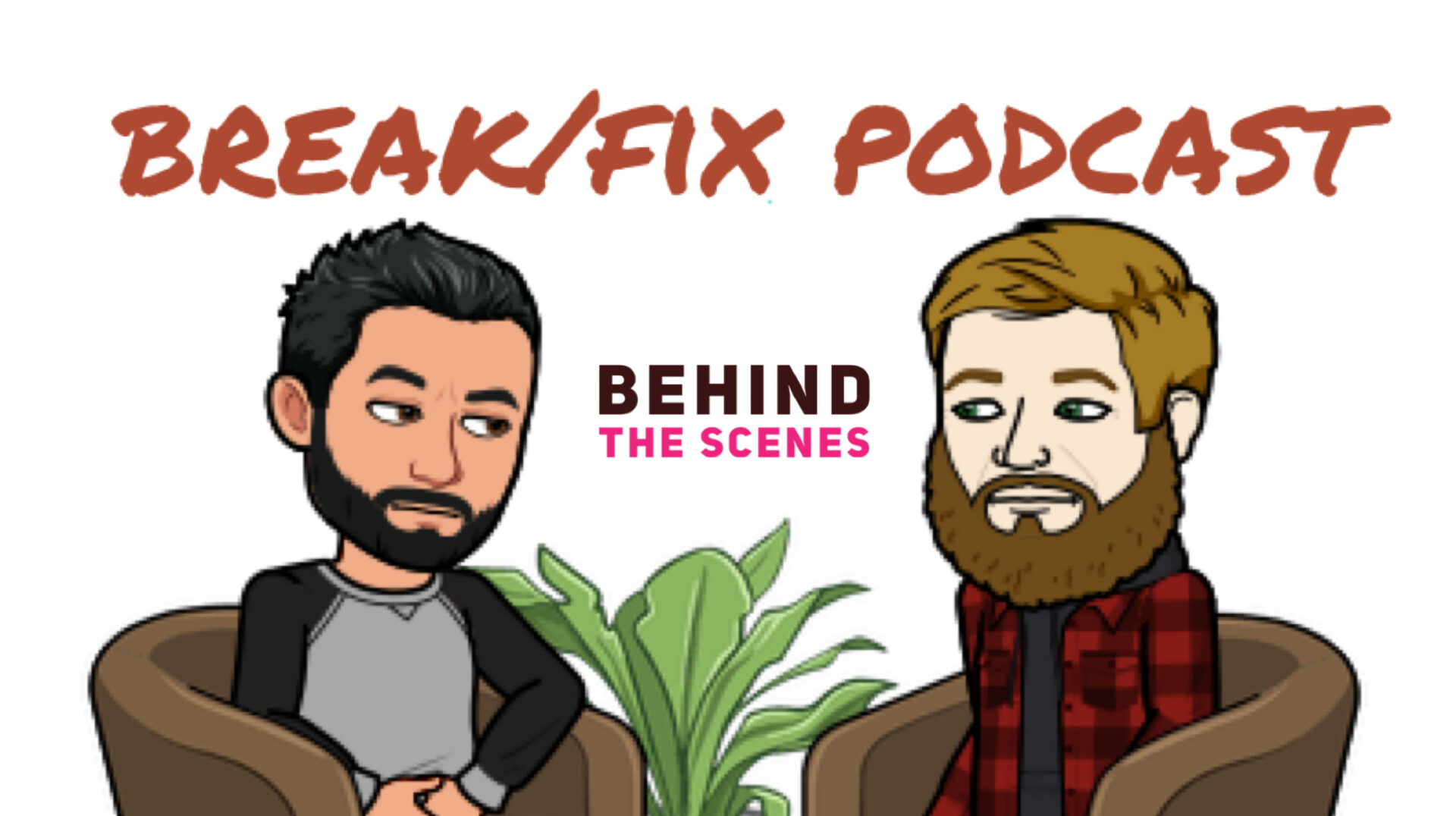
Consider becoming a GTM Patreon Supporter and get behind the scenes content and schwag!
Do you like what you've seen, heard and read? - Don't forget, GTM is fueled by volunteers and remains a no-annual-fee organization, but we still need help to pay to keep the lights on... For as little as $2.50/month you can help us keep the momentum going so we can continue to record, write, edit and broadcast your favorite content. Support GTM today! or make a One Time Donation.

If you enjoyed this episode, please go to Apple Podcasts and leave us a review. That would help us beat the algorithms and help spread the enthusiasm to others by way of Break/Fix and GTM. Subscribe to Break/Fix using your favorite Podcast App:
 |  |  |
With 31 speed records earned over a 20 year span, with many wins and titles in her log book. Lyn. St James reset more than just metrics in a record book, she rebooted the way we look and think about Motorsports. And because of her perseverance and accomplishments, she has inspired generations of talented women to also get behind the wheel of a race car.
And at 74 years young, her efforts to expand and equalize Motorsports are far from over and we can’t thank her enough for all she’s done and continues to do for the racing world at large.
To learn more about Lyn, you can visit her website www.lynstjames.com as well as her latest program www.womeninmotorsportsna.com or follow her on social @lyn.stjames on facebook or search Lyn St. James on LinkedIn.
Women in Motorsports NA (WIMNA)
Women in Motorsports North America is a community of professionals devoted to supporting opportunities for women across all disciplines of Motorsport by creating an inclusive, resourceful environment to foster mentorship, advocacy, education, and growth, thereby ensuring the continued strength and successful future of our sport.
Take the WIMNA Survey!
In 2005, this online survey, was commissioned by the Lyn St. James Foundation and conducted by Prof. Butch Fennema and Prof. James Stephens, University of Indianapolis, and Don Sabo, Ph.D. D’Youville, College, with the primary goal is to understand race fans’ attitudes toward women in racing. Participation highlights included the following and our goal is to broaden the reach through the advances in social media, etc. and our collective reach.
- 1887 motorsports fans completed the survey; 74% males, 26% females
- 95% or 1801 are US Citizens
- 85% were between the ages of 20-57 (ranging between 8 and 84)
- All 50 states were represented, as well as from 15 other countries
- The 2022 study is being done in partnership with Dr. David Ferguson, Asst Professor, Michigan Sate University. David has done considerable research in racing for over ten years with the top teams in NASCAR, IndyCar, Formula 1, and IMSA
Our ask is that you take the 10 minutes to complete the study and to comment on your experience. You might also find this current research of interest. Thanks!
Rare Find! – The Original “Girls Guide to Cars”
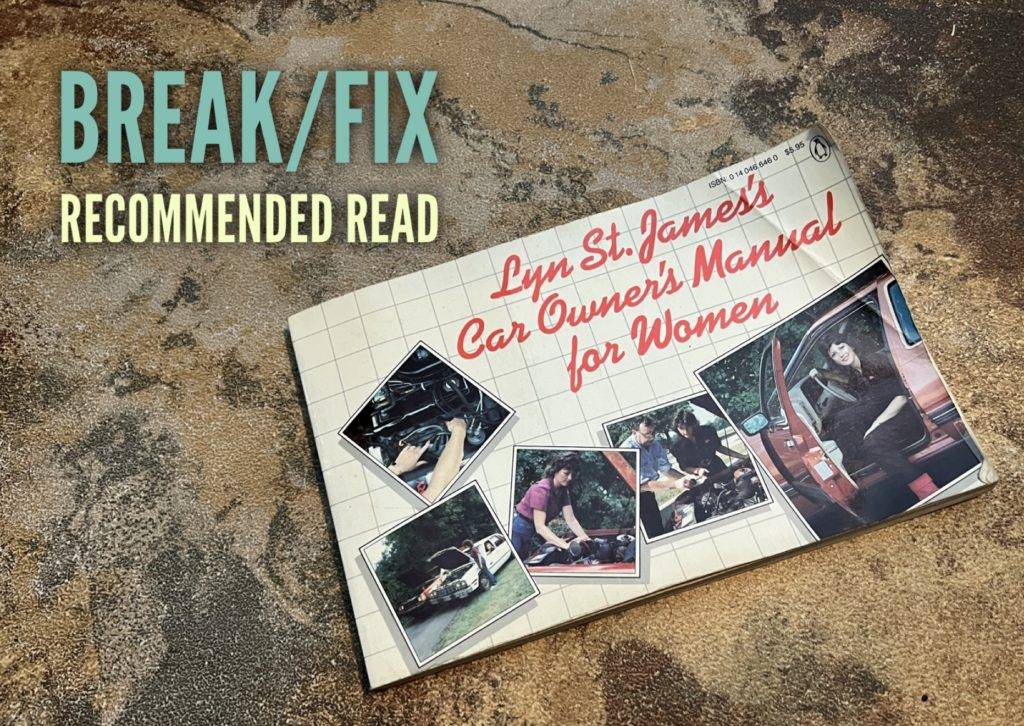
There aren’t many of these books still remaining out there in the wild. And we are very fortunate to have snagged a copy for safe keeping. This 160 page book was published in 1984 and is designed like a factory owners manual found in your glovebox -but- for Women. “Lyn St. James’s Car Owners Manual for Women” covers everything from how to change a tire, maintain your engine, to buying and selling vehicles. This might very well be the earliest execution of the “Girls Guide to Cars” idea, and we have Lyn to thank for it! #neverstoplearning
The following content has been brought to you by SRO Motorsports America and their partners at AWS, Crowdstrike, Fanatec, Pirelli, and the Skip Barber Racing School.
 | 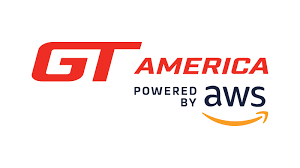 |


